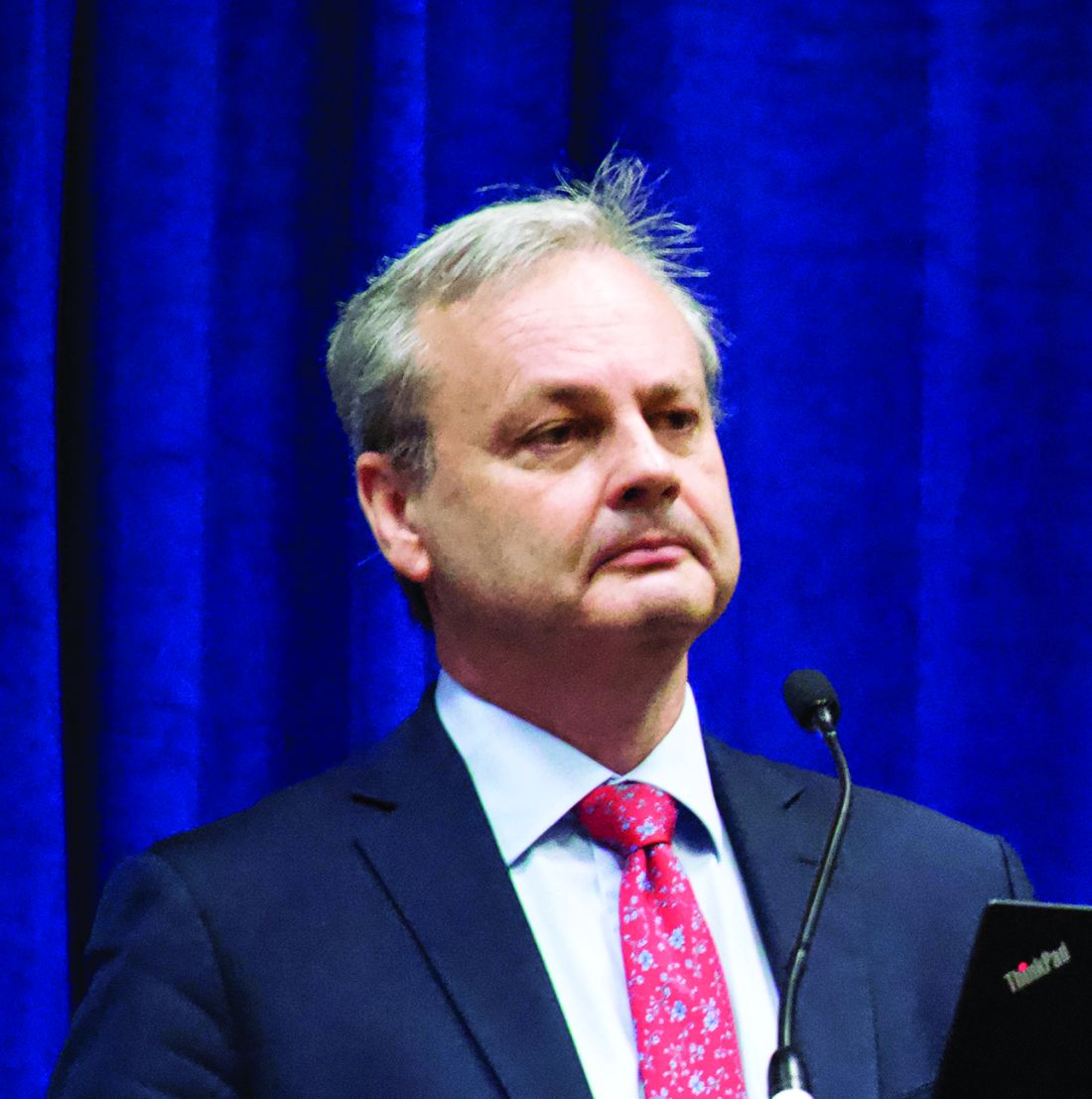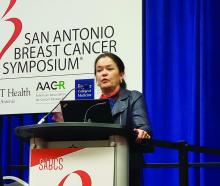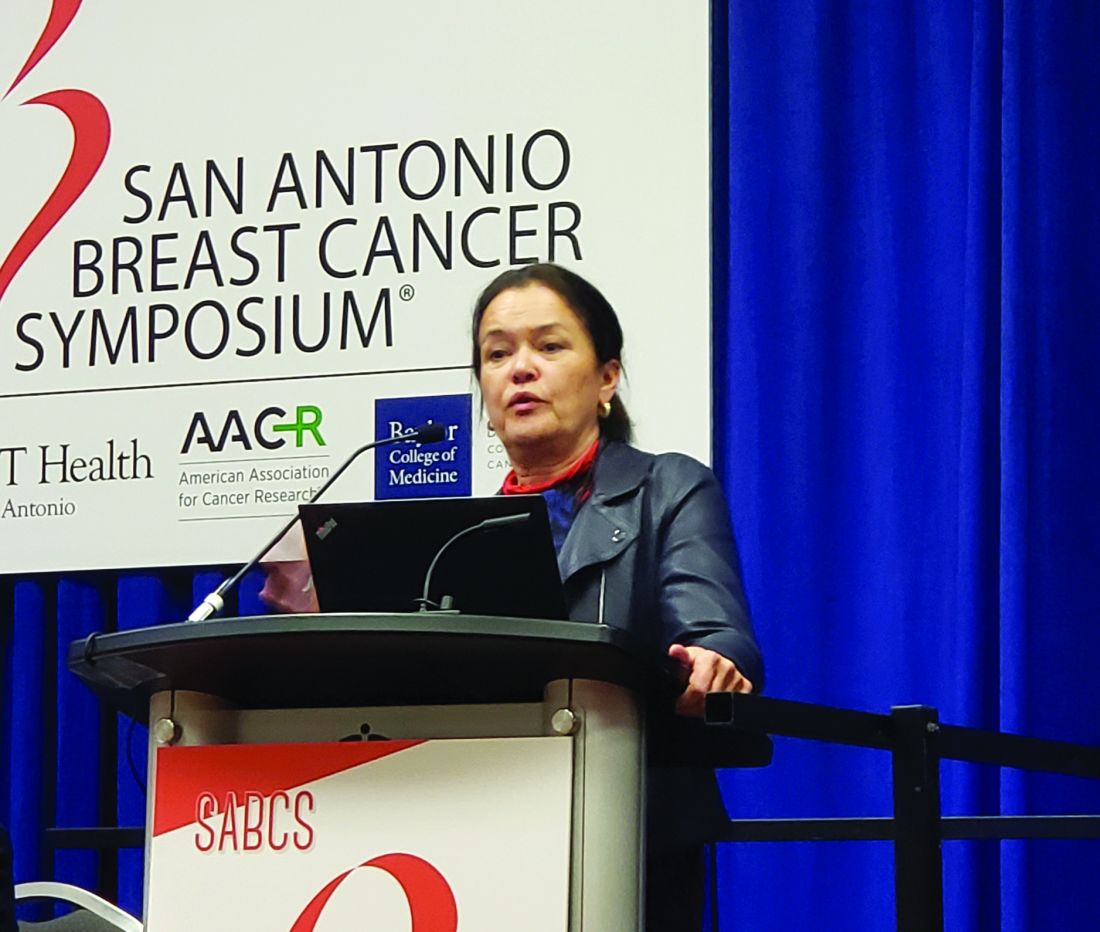User login
Residual cancer burden linked to long-term survival
SAN ANTONIO – Residual cancer burden (RCB) is poised to alter American Joint Committee on Cancer (AJCC) staging standards in breast cancer, according to investigators.
A meta-analysis showed that RCB – which is calculated in the neoadjuvant setting through a combination of primary tumor bed cellularity, lymph node positivity, and size of largest metastasis – was significantly associated with long-term survival of more than 5,000 breast cancer patients, reported principal investigator W. Fraser Symmans, MD, of MD Anderson Cancer Center, Houston, who presented the findings at the San Antonio Breast Cancer Symposium.
Coinvestigator Laura J. Esserman, MD, of the University of California, San Francisco, who was in attendance at Dr. Symmans’ presentation, put the study in context.
“The reason we did this meta-analysis was to really change the joint commission – the AJCC staging – and we expect that will happen on the basis of these results,” Dr. Esserman said. “[RBC] is, moving forward, the standard of care.”
The investigators analyzed individual-level data from 5,160 patients treated at multiple institutions. For each patient, RCB, which is scored from 0 to III, from pathologic complete response (0) to high disease burden (III), was compared with event-free survival (EFS) and disease relapse-free survival (DRFS).
The results showed that both EFS and DRFS were strongly associated with RCB for the overall population and each subtype. For instance, for triple-negative breast cancer, patients with pathologic complete response had a 10-year EFS of 86%, a rate that decreased as RCB increased from RCB-I (75%) to RCB-II (61%), and finally, RCB-III (25%). This trend was similar for patients with HR-negative/HER2-positive or HR-positive/HER2-positive disease. Risk stratification for HR-positive/HER2-negative disease deviated slightly; pathologic complete response was associated with a 10-year EFS of 81%, compared with 86% for RCB-I.
Regarding this finding, Dr. Symmans noted that RCB is most prognostic when higher levels of residual disease are present. Still, reviewing long-term risk across subtypes, Dr. Fraser emphasized the reliability of RCB as a prognostic tool.
“The strong relationship [between RCB and] risk is very clear in each and every subtype of disease,” he said. “There are very tight confidence intervals around those risk estimates.”
Multivariate analysis provided further support for this conclusion, as RCB was independently prognostic for survival in each subtype of disease.
According to Dr. Esserman, the study findings should encourage implementation of RCB in daily practice.
“There has to be training and a commitment to using this in a consistent way so that we can all rely on the information,” Dr. Esserman said. “This is critical for our patients, and this is ... how we’re going to get people to the best outcome, and [it should be done] up front, when we still have the chance to cure people.”
Session moderator Virginia Kaklamani, MD, of Mays Cancer Center, San Antonio, agreed that clinicians should use RCB in practice; however, she also explained that RCB results for some patients are not yet actionable.
“I ask my pathologist to give me the RCB score,” Dr. Kaklamani said. “The question is, what do I do with the results? It’s a little limited. In triple-negative patients I may consider giving capecitabine in the adjuvant setting, or obviously enrolling them in clinical trials. In my HER2-positive patients, I will look at the results from the KATHERINE trial and the ExteNET trial to guide me. In my HR-positive patients, I’m still waiting for results from other trials to see how these results can be interpreted. What we’ve [found] is in many trials, achieving a pathologic complete response in HR-positive patients may not be as important, but as you can see here, it looks like RCB really is.”
The investigators disclosed relationships with Seattle Genetics, Almac, Syndax, and others.
SOURCE: Yau et al. SABCS. 2019 Dec 13. Abstract GS5-01.
SAN ANTONIO – Residual cancer burden (RCB) is poised to alter American Joint Committee on Cancer (AJCC) staging standards in breast cancer, according to investigators.
A meta-analysis showed that RCB – which is calculated in the neoadjuvant setting through a combination of primary tumor bed cellularity, lymph node positivity, and size of largest metastasis – was significantly associated with long-term survival of more than 5,000 breast cancer patients, reported principal investigator W. Fraser Symmans, MD, of MD Anderson Cancer Center, Houston, who presented the findings at the San Antonio Breast Cancer Symposium.
Coinvestigator Laura J. Esserman, MD, of the University of California, San Francisco, who was in attendance at Dr. Symmans’ presentation, put the study in context.
“The reason we did this meta-analysis was to really change the joint commission – the AJCC staging – and we expect that will happen on the basis of these results,” Dr. Esserman said. “[RBC] is, moving forward, the standard of care.”
The investigators analyzed individual-level data from 5,160 patients treated at multiple institutions. For each patient, RCB, which is scored from 0 to III, from pathologic complete response (0) to high disease burden (III), was compared with event-free survival (EFS) and disease relapse-free survival (DRFS).
The results showed that both EFS and DRFS were strongly associated with RCB for the overall population and each subtype. For instance, for triple-negative breast cancer, patients with pathologic complete response had a 10-year EFS of 86%, a rate that decreased as RCB increased from RCB-I (75%) to RCB-II (61%), and finally, RCB-III (25%). This trend was similar for patients with HR-negative/HER2-positive or HR-positive/HER2-positive disease. Risk stratification for HR-positive/HER2-negative disease deviated slightly; pathologic complete response was associated with a 10-year EFS of 81%, compared with 86% for RCB-I.
Regarding this finding, Dr. Symmans noted that RCB is most prognostic when higher levels of residual disease are present. Still, reviewing long-term risk across subtypes, Dr. Fraser emphasized the reliability of RCB as a prognostic tool.
“The strong relationship [between RCB and] risk is very clear in each and every subtype of disease,” he said. “There are very tight confidence intervals around those risk estimates.”
Multivariate analysis provided further support for this conclusion, as RCB was independently prognostic for survival in each subtype of disease.
According to Dr. Esserman, the study findings should encourage implementation of RCB in daily practice.
“There has to be training and a commitment to using this in a consistent way so that we can all rely on the information,” Dr. Esserman said. “This is critical for our patients, and this is ... how we’re going to get people to the best outcome, and [it should be done] up front, when we still have the chance to cure people.”
Session moderator Virginia Kaklamani, MD, of Mays Cancer Center, San Antonio, agreed that clinicians should use RCB in practice; however, she also explained that RCB results for some patients are not yet actionable.
“I ask my pathologist to give me the RCB score,” Dr. Kaklamani said. “The question is, what do I do with the results? It’s a little limited. In triple-negative patients I may consider giving capecitabine in the adjuvant setting, or obviously enrolling them in clinical trials. In my HER2-positive patients, I will look at the results from the KATHERINE trial and the ExteNET trial to guide me. In my HR-positive patients, I’m still waiting for results from other trials to see how these results can be interpreted. What we’ve [found] is in many trials, achieving a pathologic complete response in HR-positive patients may not be as important, but as you can see here, it looks like RCB really is.”
The investigators disclosed relationships with Seattle Genetics, Almac, Syndax, and others.
SOURCE: Yau et al. SABCS. 2019 Dec 13. Abstract GS5-01.
SAN ANTONIO – Residual cancer burden (RCB) is poised to alter American Joint Committee on Cancer (AJCC) staging standards in breast cancer, according to investigators.
A meta-analysis showed that RCB – which is calculated in the neoadjuvant setting through a combination of primary tumor bed cellularity, lymph node positivity, and size of largest metastasis – was significantly associated with long-term survival of more than 5,000 breast cancer patients, reported principal investigator W. Fraser Symmans, MD, of MD Anderson Cancer Center, Houston, who presented the findings at the San Antonio Breast Cancer Symposium.
Coinvestigator Laura J. Esserman, MD, of the University of California, San Francisco, who was in attendance at Dr. Symmans’ presentation, put the study in context.
“The reason we did this meta-analysis was to really change the joint commission – the AJCC staging – and we expect that will happen on the basis of these results,” Dr. Esserman said. “[RBC] is, moving forward, the standard of care.”
The investigators analyzed individual-level data from 5,160 patients treated at multiple institutions. For each patient, RCB, which is scored from 0 to III, from pathologic complete response (0) to high disease burden (III), was compared with event-free survival (EFS) and disease relapse-free survival (DRFS).
The results showed that both EFS and DRFS were strongly associated with RCB for the overall population and each subtype. For instance, for triple-negative breast cancer, patients with pathologic complete response had a 10-year EFS of 86%, a rate that decreased as RCB increased from RCB-I (75%) to RCB-II (61%), and finally, RCB-III (25%). This trend was similar for patients with HR-negative/HER2-positive or HR-positive/HER2-positive disease. Risk stratification for HR-positive/HER2-negative disease deviated slightly; pathologic complete response was associated with a 10-year EFS of 81%, compared with 86% for RCB-I.
Regarding this finding, Dr. Symmans noted that RCB is most prognostic when higher levels of residual disease are present. Still, reviewing long-term risk across subtypes, Dr. Fraser emphasized the reliability of RCB as a prognostic tool.
“The strong relationship [between RCB and] risk is very clear in each and every subtype of disease,” he said. “There are very tight confidence intervals around those risk estimates.”
Multivariate analysis provided further support for this conclusion, as RCB was independently prognostic for survival in each subtype of disease.
According to Dr. Esserman, the study findings should encourage implementation of RCB in daily practice.
“There has to be training and a commitment to using this in a consistent way so that we can all rely on the information,” Dr. Esserman said. “This is critical for our patients, and this is ... how we’re going to get people to the best outcome, and [it should be done] up front, when we still have the chance to cure people.”
Session moderator Virginia Kaklamani, MD, of Mays Cancer Center, San Antonio, agreed that clinicians should use RCB in practice; however, she also explained that RCB results for some patients are not yet actionable.
“I ask my pathologist to give me the RCB score,” Dr. Kaklamani said. “The question is, what do I do with the results? It’s a little limited. In triple-negative patients I may consider giving capecitabine in the adjuvant setting, or obviously enrolling them in clinical trials. In my HER2-positive patients, I will look at the results from the KATHERINE trial and the ExteNET trial to guide me. In my HR-positive patients, I’m still waiting for results from other trials to see how these results can be interpreted. What we’ve [found] is in many trials, achieving a pathologic complete response in HR-positive patients may not be as important, but as you can see here, it looks like RCB really is.”
The investigators disclosed relationships with Seattle Genetics, Almac, Syndax, and others.
SOURCE: Yau et al. SABCS. 2019 Dec 13. Abstract GS5-01.
REPORTING FROM SABCS 2019
TNBC: Adding capecitabine boosts disease-free survival in prospective trial
SAN ANTONIO – For patients with early triple-negative breast cancer (TNBC), adding capecitabine to standard adjuvant chemotherapy may extend disease-free survival (DFS), based results of a phase 3 trial conducted in China.
Although capecitabine boosted DFS by approximately 6%, overall survival remained unchanged, reported lead author Junjie Li, MD, of Fudan University in Shanghai, China.
In a presentation at the San Antonio Breast Cancer Symposium, Dr. Li explained that these findings provide much-needed support for the concomitant use of capecitabine in breast cancer.
“Capecitabine has been proven [effective] in advanced breast cancer, while in earlier stage disease, available data are still inconsistent,” Dr. Li said.
To help resolve some of this uncertainty, Dr. Li and colleagues conducted an open-label, phase 3 trial involving 585 patients with TNBC who were either node positive or negative and had tumors more than 1 cm in diameter. Patients were randomized in a 1:1 ratio to receive either standard therapy with three cycles of docetaxel followed by three cycles of cyclophosphamide, epirubicin, and fluorouracil; or three cycles of capecitabine and docetaxel followed by three cycles of cyclophosphamide, epirubicin, and capecitabine.
After a median follow-up of 67 months, 288 patients had received the capecitabine regimen and 273 had undergone standard therapy. The 5-year DFS was significantly longer in the capecitabine group, at 86.26%, than the control group, at 80.23% (hazard ratio, 0.66; P = .038). This benefit extended across subgroups, Dr. Li noted. While a slight numerical difference in overall survival was seen between capecitabine and control arms, this was not statistically significant (93.27% vs. 90.55%).
The investigators described safety profiles between treatment arms as “generally comparable.” In the capecitabine group, more than one-third of patients (38.89%) had dose reductions, while 8.42% reported grade 3-4 hand-foot syndrome. Grade 3-4 toxicities were more common in the capecitabine group, including neutropenia (45.79% vs. 41.32%) and febrile neutropenia (16.5% vs. 15.97%).
“Capecitabine concomitant use with docetaxel and epirubicin may significantly improve disease-free survival in early triple-negative patients,” Dr. Li concluded. He suggested that the study regimen be viewed as an alternative adjuvant regimen, as it provided clinically meaningful improvements in survival while maintaining tolerability.
Conference attendee Mohamed El-Naghy, MD, PhD, a practicing oncologist in Oneida, N.Y., expressed concern for one aspect of the trial methodology during the question and answer session following Dr. Li’s presentation: Although all patients in the trial were considered triple negative, 10 patients had estrogen receptor/progesterone receptor (ER/PR) expression ranging from 1 to 9%, which conflicts with the definition of TNBCr provided by current guidelines, according to Dr. Li.
“It is always important to have common language,” Dr. El-Naghy said. “And if you define [TNBC by] ER/PR negativity, and still you have 10% [expression], that is unacceptable. The whole point is, I looked at your numbers – 10 patients in the whole study – maybe you say they are triple negative, but these [patients] are contamination to your sample.”
Responding to this comment, Dr. Li said that the data from these patients had a minimal impact on the study results.
“We did another analysis to exclude these 10 patients, but still the result is quite similar, because they are just 10 patients – 5 in each group,” Dr. Li said.
Invited discussant Priyanka Sharma, MD, of the University of Kansas Medical Center, Kansas City, offered some additional viewpoints on the trial.
“A large proportion of patients had non–grade III disease, and one could say that the dose of docetaxel monotherapy in the control arm was not the traditional 100 mg/m2, and that could have negatively impacted the outcomes in the control arm,” Dr. Sharma said. “In addition, the trial is representative of patients only from China, and whether these findings would hold true in other ethnic and racial groups is not known. Furthermore, there seemed to be limited efficacy in patients with N0 disease, which comprised two-thirds of the trial.”
Despite these potential limitations, based on the trial results and other evidence, Dr. Sharma suggested that adding capecitabine to standard systemic therapy may be considered a viable option for patients with early TNBC.
The investigators reported no disclosures.
SOURCE: Li J et al. SABCS 2019, Abstract GS1-08.
SAN ANTONIO – For patients with early triple-negative breast cancer (TNBC), adding capecitabine to standard adjuvant chemotherapy may extend disease-free survival (DFS), based results of a phase 3 trial conducted in China.
Although capecitabine boosted DFS by approximately 6%, overall survival remained unchanged, reported lead author Junjie Li, MD, of Fudan University in Shanghai, China.
In a presentation at the San Antonio Breast Cancer Symposium, Dr. Li explained that these findings provide much-needed support for the concomitant use of capecitabine in breast cancer.
“Capecitabine has been proven [effective] in advanced breast cancer, while in earlier stage disease, available data are still inconsistent,” Dr. Li said.
To help resolve some of this uncertainty, Dr. Li and colleagues conducted an open-label, phase 3 trial involving 585 patients with TNBC who were either node positive or negative and had tumors more than 1 cm in diameter. Patients were randomized in a 1:1 ratio to receive either standard therapy with three cycles of docetaxel followed by three cycles of cyclophosphamide, epirubicin, and fluorouracil; or three cycles of capecitabine and docetaxel followed by three cycles of cyclophosphamide, epirubicin, and capecitabine.
After a median follow-up of 67 months, 288 patients had received the capecitabine regimen and 273 had undergone standard therapy. The 5-year DFS was significantly longer in the capecitabine group, at 86.26%, than the control group, at 80.23% (hazard ratio, 0.66; P = .038). This benefit extended across subgroups, Dr. Li noted. While a slight numerical difference in overall survival was seen between capecitabine and control arms, this was not statistically significant (93.27% vs. 90.55%).
The investigators described safety profiles between treatment arms as “generally comparable.” In the capecitabine group, more than one-third of patients (38.89%) had dose reductions, while 8.42% reported grade 3-4 hand-foot syndrome. Grade 3-4 toxicities were more common in the capecitabine group, including neutropenia (45.79% vs. 41.32%) and febrile neutropenia (16.5% vs. 15.97%).
“Capecitabine concomitant use with docetaxel and epirubicin may significantly improve disease-free survival in early triple-negative patients,” Dr. Li concluded. He suggested that the study regimen be viewed as an alternative adjuvant regimen, as it provided clinically meaningful improvements in survival while maintaining tolerability.
Conference attendee Mohamed El-Naghy, MD, PhD, a practicing oncologist in Oneida, N.Y., expressed concern for one aspect of the trial methodology during the question and answer session following Dr. Li’s presentation: Although all patients in the trial were considered triple negative, 10 patients had estrogen receptor/progesterone receptor (ER/PR) expression ranging from 1 to 9%, which conflicts with the definition of TNBCr provided by current guidelines, according to Dr. Li.
“It is always important to have common language,” Dr. El-Naghy said. “And if you define [TNBC by] ER/PR negativity, and still you have 10% [expression], that is unacceptable. The whole point is, I looked at your numbers – 10 patients in the whole study – maybe you say they are triple negative, but these [patients] are contamination to your sample.”
Responding to this comment, Dr. Li said that the data from these patients had a minimal impact on the study results.
“We did another analysis to exclude these 10 patients, but still the result is quite similar, because they are just 10 patients – 5 in each group,” Dr. Li said.
Invited discussant Priyanka Sharma, MD, of the University of Kansas Medical Center, Kansas City, offered some additional viewpoints on the trial.
“A large proportion of patients had non–grade III disease, and one could say that the dose of docetaxel monotherapy in the control arm was not the traditional 100 mg/m2, and that could have negatively impacted the outcomes in the control arm,” Dr. Sharma said. “In addition, the trial is representative of patients only from China, and whether these findings would hold true in other ethnic and racial groups is not known. Furthermore, there seemed to be limited efficacy in patients with N0 disease, which comprised two-thirds of the trial.”
Despite these potential limitations, based on the trial results and other evidence, Dr. Sharma suggested that adding capecitabine to standard systemic therapy may be considered a viable option for patients with early TNBC.
The investigators reported no disclosures.
SOURCE: Li J et al. SABCS 2019, Abstract GS1-08.
SAN ANTONIO – For patients with early triple-negative breast cancer (TNBC), adding capecitabine to standard adjuvant chemotherapy may extend disease-free survival (DFS), based results of a phase 3 trial conducted in China.
Although capecitabine boosted DFS by approximately 6%, overall survival remained unchanged, reported lead author Junjie Li, MD, of Fudan University in Shanghai, China.
In a presentation at the San Antonio Breast Cancer Symposium, Dr. Li explained that these findings provide much-needed support for the concomitant use of capecitabine in breast cancer.
“Capecitabine has been proven [effective] in advanced breast cancer, while in earlier stage disease, available data are still inconsistent,” Dr. Li said.
To help resolve some of this uncertainty, Dr. Li and colleagues conducted an open-label, phase 3 trial involving 585 patients with TNBC who were either node positive or negative and had tumors more than 1 cm in diameter. Patients were randomized in a 1:1 ratio to receive either standard therapy with three cycles of docetaxel followed by three cycles of cyclophosphamide, epirubicin, and fluorouracil; or three cycles of capecitabine and docetaxel followed by three cycles of cyclophosphamide, epirubicin, and capecitabine.
After a median follow-up of 67 months, 288 patients had received the capecitabine regimen and 273 had undergone standard therapy. The 5-year DFS was significantly longer in the capecitabine group, at 86.26%, than the control group, at 80.23% (hazard ratio, 0.66; P = .038). This benefit extended across subgroups, Dr. Li noted. While a slight numerical difference in overall survival was seen between capecitabine and control arms, this was not statistically significant (93.27% vs. 90.55%).
The investigators described safety profiles between treatment arms as “generally comparable.” In the capecitabine group, more than one-third of patients (38.89%) had dose reductions, while 8.42% reported grade 3-4 hand-foot syndrome. Grade 3-4 toxicities were more common in the capecitabine group, including neutropenia (45.79% vs. 41.32%) and febrile neutropenia (16.5% vs. 15.97%).
“Capecitabine concomitant use with docetaxel and epirubicin may significantly improve disease-free survival in early triple-negative patients,” Dr. Li concluded. He suggested that the study regimen be viewed as an alternative adjuvant regimen, as it provided clinically meaningful improvements in survival while maintaining tolerability.
Conference attendee Mohamed El-Naghy, MD, PhD, a practicing oncologist in Oneida, N.Y., expressed concern for one aspect of the trial methodology during the question and answer session following Dr. Li’s presentation: Although all patients in the trial were considered triple negative, 10 patients had estrogen receptor/progesterone receptor (ER/PR) expression ranging from 1 to 9%, which conflicts with the definition of TNBCr provided by current guidelines, according to Dr. Li.
“It is always important to have common language,” Dr. El-Naghy said. “And if you define [TNBC by] ER/PR negativity, and still you have 10% [expression], that is unacceptable. The whole point is, I looked at your numbers – 10 patients in the whole study – maybe you say they are triple negative, but these [patients] are contamination to your sample.”
Responding to this comment, Dr. Li said that the data from these patients had a minimal impact on the study results.
“We did another analysis to exclude these 10 patients, but still the result is quite similar, because they are just 10 patients – 5 in each group,” Dr. Li said.
Invited discussant Priyanka Sharma, MD, of the University of Kansas Medical Center, Kansas City, offered some additional viewpoints on the trial.
“A large proportion of patients had non–grade III disease, and one could say that the dose of docetaxel monotherapy in the control arm was not the traditional 100 mg/m2, and that could have negatively impacted the outcomes in the control arm,” Dr. Sharma said. “In addition, the trial is representative of patients only from China, and whether these findings would hold true in other ethnic and racial groups is not known. Furthermore, there seemed to be limited efficacy in patients with N0 disease, which comprised two-thirds of the trial.”
Despite these potential limitations, based on the trial results and other evidence, Dr. Sharma suggested that adding capecitabine to standard systemic therapy may be considered a viable option for patients with early TNBC.
The investigators reported no disclosures.
SOURCE: Li J et al. SABCS 2019, Abstract GS1-08.
REPORTING FROM SABCS 2019
Pembrolizumab plus chemo boosts pCR rate in TNBC
SAN ANTONIO – Adding pembrolizumab to chemotherapy in the neoadjuvant setting increased the likelihood that women with stage III or early node-positive triple-negative breast cancer (TNBC) would have a pathologic complete response and sustained clinical benefit, results of the phase 3 KEYNOTE-522 study showed.
Among 602 patients evaluable in a definitive pathological complete response (pCR) analysis, the pCR rate was 64.8% for those treated with chemotherapy plus pembrolizumab (Keytruda), compared with 51.2% for patients treated with chemotherapy plus placebo, reported Peter Schmid, MD, PhD, from Barts Cancer Institute in London.
“The addition of neoadjuvant pembrolizumab to chemotherapy provided a significant increase in the path CR rate in all patients, but also a larger magnitude of path CR benefit versus chemotherapy alone in patients with higher-risk disease, such as stage III disease or node-positive early triple-negative breast cancer,” he said at the annual San Antonio Breast Cancer Symposium.
The overall pCR results were originally reported at the 2019 annual meeting of the European Society for Medical Oncology. At SABCS 2019, he reported pCR results for specific subgroups in KEYNOTE-522.
Investigators enrolled patients aged 18 years or older with newly diagnosed TNBC of either stage T1cN1-2, or T2-4N0-2 and an Eastern Cooperative Oncology Group performance status of 0 or 1. Patients also had to have at least two separate tumor cores from the primary tumor for assessment of programmed death–ligand 1 (PD-L1).
After stratification for nodal status, tumor size, and carboplatin schedule (once weekly or every 3 weeks), patients were randomized to receive either pembrolizumab 200 mg every 3 weeks or placebo plus neoadjuvant carboplatin and paclitaxel for four 3-week cycles, followed by four cycles of chemotherapy with either doxorubicin or epirubicin plus cyclophosphamide (AC or EC). Patients went on to surgery, then received adjuvant therapy for nine cycles with either pembrolizumab at the neoadjuvant dose and schedule or placebo.
At the first preplanned interim analysis for event-free survival (EFS) based on 1,174 patients followed for a median of 15.5 months, events had occurred in 7.4% of patients on pembro/chemo, compared with 11.8% on placebo/chemo, but this difference did not meet the prespecified P value boundary of .000051 for significance, Dr. Schmid acknowledged.
When the investigators looked at pCR by disease stage, however, they saw the following benefits across all stages in the study:
- Stage IIA: 73.1% with pembrolizumab versus 62.1% with placebo, difference 11%.
- Stage IIB: 56.2% versus 48.4%, difference 7.8%.
- Stage IIIA: 66.7% versus 42.1%, difference 24.6%.
- Stage IIIB: 48.6% versus 23.1%, difference 25.6%.
The greatest benefit for the addition of pembrolizumab to chemotherapy appeared to be in the higher disease stages, Dr. Schmid said.
There was also a benefit from pembrolizumab for patients with both node-negative disease (pCR, 64.9% vs. 58.6% in the placebo arm) and node-positive disease (64.8% vs. 44.1%, respectively).
pCR rates were also superior with pembrolizumab versus placebo in patients who were PD-L1 negative, defined as a combined positive score (CPS) less than 1 (45.3% vs. 30.3%), as well as PD-L1–positive patients at each of three cutoff values: CPS 1 or greater (68.9% vs. 54.9%), CPS 10 or greater (77.9% vs. 59.8%), and CPS 20 or greater (81.7% vs. 62.5%).
Interestingly, adding pembrolizumab boosted pCR rates both in patients with exposure to a full planned course of chemotherapy (69.7% vs. 55.3% with placebo) and in those who received less than the full course (51.1% vs. 35.7%).
The most common immune-mediated adverse events with the largest between-group differences involved the thyroid, including hypothyroidism (in 14.9% of patients on pembrolizumab and 5.7% of those on placebo), hyperthyroidism (5.1% vs. 1.8%), and thyroiditis (1.7% vs. 1.0%).
“Immune-mediated adverse events are consistent with the known profiles of each regimen, and there’s no new safety signal, no new safety concern at this point in time,” Dr. Schmid said.
Further follow-up will be needed to determine EFS benefit and long-term safety. Investigators plan to perform additional biomarker analyses, including tumor-infiltrating lymphocytes and BRCA, he added.
“Will the KEYNOTE-522 regimen be the new standard of care if approved?” asked invited discussant Kevin Kalinsky, MD, MS, from Columbia University Irving Medical Center in New York. “These are exciting data, both in pCR and early event-free survival. But there’s a risk: a risk of overtreatment, as well as potentially [serious] toxicity in patients with curable disease.”
“The take-home is that this regimen will likely be practice changing in some patients, and with the absence of having a predictor, the benefit may outweigh the risk most in patients with high clinical risk,” he added.
The study was funded by Merck Sharp & Dohme. Dr. Schmid reported advising/consulting for and receiving honoraria from Merck. Dr. Kalinsky disclosed has disclosed that he receives salary from Array Biopharma, has received fees from various companies (not including Merck), and has contracted research with multiple companies, not including Merck.
SOURCE: Schmid P et al. SABCS 2019, Abstract GS3-03.
SAN ANTONIO – Adding pembrolizumab to chemotherapy in the neoadjuvant setting increased the likelihood that women with stage III or early node-positive triple-negative breast cancer (TNBC) would have a pathologic complete response and sustained clinical benefit, results of the phase 3 KEYNOTE-522 study showed.
Among 602 patients evaluable in a definitive pathological complete response (pCR) analysis, the pCR rate was 64.8% for those treated with chemotherapy plus pembrolizumab (Keytruda), compared with 51.2% for patients treated with chemotherapy plus placebo, reported Peter Schmid, MD, PhD, from Barts Cancer Institute in London.
“The addition of neoadjuvant pembrolizumab to chemotherapy provided a significant increase in the path CR rate in all patients, but also a larger magnitude of path CR benefit versus chemotherapy alone in patients with higher-risk disease, such as stage III disease or node-positive early triple-negative breast cancer,” he said at the annual San Antonio Breast Cancer Symposium.
The overall pCR results were originally reported at the 2019 annual meeting of the European Society for Medical Oncology. At SABCS 2019, he reported pCR results for specific subgroups in KEYNOTE-522.
Investigators enrolled patients aged 18 years or older with newly diagnosed TNBC of either stage T1cN1-2, or T2-4N0-2 and an Eastern Cooperative Oncology Group performance status of 0 or 1. Patients also had to have at least two separate tumor cores from the primary tumor for assessment of programmed death–ligand 1 (PD-L1).
After stratification for nodal status, tumor size, and carboplatin schedule (once weekly or every 3 weeks), patients were randomized to receive either pembrolizumab 200 mg every 3 weeks or placebo plus neoadjuvant carboplatin and paclitaxel for four 3-week cycles, followed by four cycles of chemotherapy with either doxorubicin or epirubicin plus cyclophosphamide (AC or EC). Patients went on to surgery, then received adjuvant therapy for nine cycles with either pembrolizumab at the neoadjuvant dose and schedule or placebo.
At the first preplanned interim analysis for event-free survival (EFS) based on 1,174 patients followed for a median of 15.5 months, events had occurred in 7.4% of patients on pembro/chemo, compared with 11.8% on placebo/chemo, but this difference did not meet the prespecified P value boundary of .000051 for significance, Dr. Schmid acknowledged.
When the investigators looked at pCR by disease stage, however, they saw the following benefits across all stages in the study:
- Stage IIA: 73.1% with pembrolizumab versus 62.1% with placebo, difference 11%.
- Stage IIB: 56.2% versus 48.4%, difference 7.8%.
- Stage IIIA: 66.7% versus 42.1%, difference 24.6%.
- Stage IIIB: 48.6% versus 23.1%, difference 25.6%.
The greatest benefit for the addition of pembrolizumab to chemotherapy appeared to be in the higher disease stages, Dr. Schmid said.
There was also a benefit from pembrolizumab for patients with both node-negative disease (pCR, 64.9% vs. 58.6% in the placebo arm) and node-positive disease (64.8% vs. 44.1%, respectively).
pCR rates were also superior with pembrolizumab versus placebo in patients who were PD-L1 negative, defined as a combined positive score (CPS) less than 1 (45.3% vs. 30.3%), as well as PD-L1–positive patients at each of three cutoff values: CPS 1 or greater (68.9% vs. 54.9%), CPS 10 or greater (77.9% vs. 59.8%), and CPS 20 or greater (81.7% vs. 62.5%).
Interestingly, adding pembrolizumab boosted pCR rates both in patients with exposure to a full planned course of chemotherapy (69.7% vs. 55.3% with placebo) and in those who received less than the full course (51.1% vs. 35.7%).
The most common immune-mediated adverse events with the largest between-group differences involved the thyroid, including hypothyroidism (in 14.9% of patients on pembrolizumab and 5.7% of those on placebo), hyperthyroidism (5.1% vs. 1.8%), and thyroiditis (1.7% vs. 1.0%).
“Immune-mediated adverse events are consistent with the known profiles of each regimen, and there’s no new safety signal, no new safety concern at this point in time,” Dr. Schmid said.
Further follow-up will be needed to determine EFS benefit and long-term safety. Investigators plan to perform additional biomarker analyses, including tumor-infiltrating lymphocytes and BRCA, he added.
“Will the KEYNOTE-522 regimen be the new standard of care if approved?” asked invited discussant Kevin Kalinsky, MD, MS, from Columbia University Irving Medical Center in New York. “These are exciting data, both in pCR and early event-free survival. But there’s a risk: a risk of overtreatment, as well as potentially [serious] toxicity in patients with curable disease.”
“The take-home is that this regimen will likely be practice changing in some patients, and with the absence of having a predictor, the benefit may outweigh the risk most in patients with high clinical risk,” he added.
The study was funded by Merck Sharp & Dohme. Dr. Schmid reported advising/consulting for and receiving honoraria from Merck. Dr. Kalinsky disclosed has disclosed that he receives salary from Array Biopharma, has received fees from various companies (not including Merck), and has contracted research with multiple companies, not including Merck.
SOURCE: Schmid P et al. SABCS 2019, Abstract GS3-03.
SAN ANTONIO – Adding pembrolizumab to chemotherapy in the neoadjuvant setting increased the likelihood that women with stage III or early node-positive triple-negative breast cancer (TNBC) would have a pathologic complete response and sustained clinical benefit, results of the phase 3 KEYNOTE-522 study showed.
Among 602 patients evaluable in a definitive pathological complete response (pCR) analysis, the pCR rate was 64.8% for those treated with chemotherapy plus pembrolizumab (Keytruda), compared with 51.2% for patients treated with chemotherapy plus placebo, reported Peter Schmid, MD, PhD, from Barts Cancer Institute in London.
“The addition of neoadjuvant pembrolizumab to chemotherapy provided a significant increase in the path CR rate in all patients, but also a larger magnitude of path CR benefit versus chemotherapy alone in patients with higher-risk disease, such as stage III disease or node-positive early triple-negative breast cancer,” he said at the annual San Antonio Breast Cancer Symposium.
The overall pCR results were originally reported at the 2019 annual meeting of the European Society for Medical Oncology. At SABCS 2019, he reported pCR results for specific subgroups in KEYNOTE-522.
Investigators enrolled patients aged 18 years or older with newly diagnosed TNBC of either stage T1cN1-2, or T2-4N0-2 and an Eastern Cooperative Oncology Group performance status of 0 or 1. Patients also had to have at least two separate tumor cores from the primary tumor for assessment of programmed death–ligand 1 (PD-L1).
After stratification for nodal status, tumor size, and carboplatin schedule (once weekly or every 3 weeks), patients were randomized to receive either pembrolizumab 200 mg every 3 weeks or placebo plus neoadjuvant carboplatin and paclitaxel for four 3-week cycles, followed by four cycles of chemotherapy with either doxorubicin or epirubicin plus cyclophosphamide (AC or EC). Patients went on to surgery, then received adjuvant therapy for nine cycles with either pembrolizumab at the neoadjuvant dose and schedule or placebo.
At the first preplanned interim analysis for event-free survival (EFS) based on 1,174 patients followed for a median of 15.5 months, events had occurred in 7.4% of patients on pembro/chemo, compared with 11.8% on placebo/chemo, but this difference did not meet the prespecified P value boundary of .000051 for significance, Dr. Schmid acknowledged.
When the investigators looked at pCR by disease stage, however, they saw the following benefits across all stages in the study:
- Stage IIA: 73.1% with pembrolizumab versus 62.1% with placebo, difference 11%.
- Stage IIB: 56.2% versus 48.4%, difference 7.8%.
- Stage IIIA: 66.7% versus 42.1%, difference 24.6%.
- Stage IIIB: 48.6% versus 23.1%, difference 25.6%.
The greatest benefit for the addition of pembrolizumab to chemotherapy appeared to be in the higher disease stages, Dr. Schmid said.
There was also a benefit from pembrolizumab for patients with both node-negative disease (pCR, 64.9% vs. 58.6% in the placebo arm) and node-positive disease (64.8% vs. 44.1%, respectively).
pCR rates were also superior with pembrolizumab versus placebo in patients who were PD-L1 negative, defined as a combined positive score (CPS) less than 1 (45.3% vs. 30.3%), as well as PD-L1–positive patients at each of three cutoff values: CPS 1 or greater (68.9% vs. 54.9%), CPS 10 or greater (77.9% vs. 59.8%), and CPS 20 or greater (81.7% vs. 62.5%).
Interestingly, adding pembrolizumab boosted pCR rates both in patients with exposure to a full planned course of chemotherapy (69.7% vs. 55.3% with placebo) and in those who received less than the full course (51.1% vs. 35.7%).
The most common immune-mediated adverse events with the largest between-group differences involved the thyroid, including hypothyroidism (in 14.9% of patients on pembrolizumab and 5.7% of those on placebo), hyperthyroidism (5.1% vs. 1.8%), and thyroiditis (1.7% vs. 1.0%).
“Immune-mediated adverse events are consistent with the known profiles of each regimen, and there’s no new safety signal, no new safety concern at this point in time,” Dr. Schmid said.
Further follow-up will be needed to determine EFS benefit and long-term safety. Investigators plan to perform additional biomarker analyses, including tumor-infiltrating lymphocytes and BRCA, he added.
“Will the KEYNOTE-522 regimen be the new standard of care if approved?” asked invited discussant Kevin Kalinsky, MD, MS, from Columbia University Irving Medical Center in New York. “These are exciting data, both in pCR and early event-free survival. But there’s a risk: a risk of overtreatment, as well as potentially [serious] toxicity in patients with curable disease.”
“The take-home is that this regimen will likely be practice changing in some patients, and with the absence of having a predictor, the benefit may outweigh the risk most in patients with high clinical risk,” he added.
The study was funded by Merck Sharp & Dohme. Dr. Schmid reported advising/consulting for and receiving honoraria from Merck. Dr. Kalinsky disclosed has disclosed that he receives salary from Array Biopharma, has received fees from various companies (not including Merck), and has contracted research with multiple companies, not including Merck.
SOURCE: Schmid P et al. SABCS 2019, Abstract GS3-03.
REPORTING FROM SABCS 2019
Promising new neoadjuvant strategy in luminal B breast cancer
SAN ANTONIO – The combination of ribociclib and letrozole proved to be an attractive alternative to standard multidrug neoadjuvant chemotherapy for women with high-risk luminal B breast cancer in the exploratory phase 2 SOLTI-1402/CORALLEEN trial.
Neoadjuvant therapy with ribociclib (Kisqali), an inhibitor of cyclin-dependent kinases 4 and 6 (CDK4/6), in combination with the aromatase inhibitor letrozole (Femara) proved as effective for presurgical molecular disease downstaging as standard multiagent chemotherapy, but with considerably less toxicity, Joaquín Gavilá, MD, reported at the San Antonio Breast Cancer Symposium.
“We believe that these results suggest that in clinically high-risk luminal B disease, a chemotherapy-free treatment strategy based upon CDK4/6 inhibition is worth exploring in future neoadjuvant trials,” declared Dr. Gavilá, a medical oncologist at the Valencia (Spain) Institute of Oncology.
SOLTI-1402/CORALLEEN was an open-label, multicenter trial involving 106 postmenopausal women with hormone receptor–positive and HER2-negative stage I-IIIA breast cancer, an operable tumor size of at least 2 cm measured by MRI, and high-risk luminal B subtype disease as defined via the Prosigna genomic tumor profiling test, also known as PAM50, on which they had a baseline median Risk of Recurrence (ROR) score of 74 out of a possible 100 points. The luminal B subtype accounts for 30%-40% of all hormone receptor–positive/HER2-negative breast cancer and carries a greater than 10% risk of distant recurrence at 10 years.
The women were randomized to 6 months of neoadjuvant therapy involving one of two regimens: six 28-day cycles of oral ribociclib at 600 mg once daily for 3 weeks followed by 1 week off plus daily oral letrozole at 2.5 mg/day; or four cycles of intravenous doxorubicin at 60 mg/m2 and cyclophosphamide at 600 mg/m2 every 21 days, then weekly intravenous paclitaxel at 80 mg/m2 for 12 weeks.
The primary study endpoint was achievement of a low ROR score at the time of surgery: that is, a score below 40 points if pathologically node-negative at surgery, and below 15 with one to three positive nodes, which are the cutoffs for a less than 10% risk of distant recurrence at 10 years. A low ROR score was accomplished in 47% of the ribociclib/letrozole group and 46% of patients on standard multiagent chemotherapy. The median ROR score improved from 74 points at baseline to 18 in the investigational treatment arm and 25 in the standard chemotherapy arm.
“In other words, we observed that nearly half of the patients were downstaged from high risk to low risk in both treatment arms,” Dr. Gavilá noted.
Another 31% of patients in both treatment arms were ROR-intermediate at surgery.
The reduction in ROR score at day 15 of the study was more pronounced in the ribociclib/letrozole group than in the chemotherapy arm.
Turning to secondary outcomes, Dr. Gavilá noted that a Residual Cancer Burden score of 0 or 1, correlating with a pathologic complete response or minimal residual disease at time of surgery, was documented in 6% of the ribociclib/letrozole group and 12% of the chemotherapy group. A Preoperative Endocrine Prognostic Index (PEPI) score of 0 was attained in 22% of the novel treatment group and similarly in 17% of those on chemotherapy. Median levels of the tumor cell proliferation biomarker Ki 67 improved from 32% at baseline to 3% in the ribociclib/letrozole group and 10% in the chemotherapy arm. Eighty-eight percent of the ribociclib/letrozole group converted from luminal B to the less aggressive luminal A intrinsic subtype, as did 83% of patients following neoadjuvant chemotherapy.
The rate of serious adverse events was 4% in the ribociclib/letrozole group and 15% in the chemotherapy arm. The most common grade 3 or higher adverse event was neutropenia in both study arms, followed by increased transaminase levels in the ribociclib/letrozole group and febrile neutropenia in the chemotherapy arm. Fifty-nine percent of the ribociclib/letrozole group experienced an adverse event leading to dose reduction or temporary interruption of treatment, as did 83% of the chemotherapy group.
The SOLTI-1402/CORALLEEN trial was sponsored by Novartis, the Breast Cancer Research Foundation, The American Association for Cancer Research, and the Breast Cancer Now Career Catalyst. Dr. Gavilá reported serving as a consultant to Novartis, Roche, and MSD.
Simultaneously with Dr. Gavilá’s presentation in San Antonio, the study results were published online in The Lancet Oncology.
In an accompanying editorial, Massimo Cristofanilli, MD, opined that while the novel neoadjuvant treatment strategy tested in SOLTI-1402/CORALLEEN is promising, the most important concept introduced in the study is that a molecular subtyping tool such the Prosigna test can be used to assess the success of neoadjuvant therapy.
“The increasing availability of molecular testing in both the primary and metastatic setting is contributing to a change in the ability to stratify, select, and monitor disease biology and molecular evolution. This is resulting in the introduction of new frameworks in breast cancer treatments with potentially profound effects on patient outcomes and quality of life,” according to Dr. Cristofanilli, professor of medicine at Northwestern University, Chicago.
SOURCE: Gavilá J. SABCS 2019 Abstract GS2-06.
SAN ANTONIO – The combination of ribociclib and letrozole proved to be an attractive alternative to standard multidrug neoadjuvant chemotherapy for women with high-risk luminal B breast cancer in the exploratory phase 2 SOLTI-1402/CORALLEEN trial.
Neoadjuvant therapy with ribociclib (Kisqali), an inhibitor of cyclin-dependent kinases 4 and 6 (CDK4/6), in combination with the aromatase inhibitor letrozole (Femara) proved as effective for presurgical molecular disease downstaging as standard multiagent chemotherapy, but with considerably less toxicity, Joaquín Gavilá, MD, reported at the San Antonio Breast Cancer Symposium.
“We believe that these results suggest that in clinically high-risk luminal B disease, a chemotherapy-free treatment strategy based upon CDK4/6 inhibition is worth exploring in future neoadjuvant trials,” declared Dr. Gavilá, a medical oncologist at the Valencia (Spain) Institute of Oncology.
SOLTI-1402/CORALLEEN was an open-label, multicenter trial involving 106 postmenopausal women with hormone receptor–positive and HER2-negative stage I-IIIA breast cancer, an operable tumor size of at least 2 cm measured by MRI, and high-risk luminal B subtype disease as defined via the Prosigna genomic tumor profiling test, also known as PAM50, on which they had a baseline median Risk of Recurrence (ROR) score of 74 out of a possible 100 points. The luminal B subtype accounts for 30%-40% of all hormone receptor–positive/HER2-negative breast cancer and carries a greater than 10% risk of distant recurrence at 10 years.
The women were randomized to 6 months of neoadjuvant therapy involving one of two regimens: six 28-day cycles of oral ribociclib at 600 mg once daily for 3 weeks followed by 1 week off plus daily oral letrozole at 2.5 mg/day; or four cycles of intravenous doxorubicin at 60 mg/m2 and cyclophosphamide at 600 mg/m2 every 21 days, then weekly intravenous paclitaxel at 80 mg/m2 for 12 weeks.
The primary study endpoint was achievement of a low ROR score at the time of surgery: that is, a score below 40 points if pathologically node-negative at surgery, and below 15 with one to three positive nodes, which are the cutoffs for a less than 10% risk of distant recurrence at 10 years. A low ROR score was accomplished in 47% of the ribociclib/letrozole group and 46% of patients on standard multiagent chemotherapy. The median ROR score improved from 74 points at baseline to 18 in the investigational treatment arm and 25 in the standard chemotherapy arm.
“In other words, we observed that nearly half of the patients were downstaged from high risk to low risk in both treatment arms,” Dr. Gavilá noted.
Another 31% of patients in both treatment arms were ROR-intermediate at surgery.
The reduction in ROR score at day 15 of the study was more pronounced in the ribociclib/letrozole group than in the chemotherapy arm.
Turning to secondary outcomes, Dr. Gavilá noted that a Residual Cancer Burden score of 0 or 1, correlating with a pathologic complete response or minimal residual disease at time of surgery, was documented in 6% of the ribociclib/letrozole group and 12% of the chemotherapy group. A Preoperative Endocrine Prognostic Index (PEPI) score of 0 was attained in 22% of the novel treatment group and similarly in 17% of those on chemotherapy. Median levels of the tumor cell proliferation biomarker Ki 67 improved from 32% at baseline to 3% in the ribociclib/letrozole group and 10% in the chemotherapy arm. Eighty-eight percent of the ribociclib/letrozole group converted from luminal B to the less aggressive luminal A intrinsic subtype, as did 83% of patients following neoadjuvant chemotherapy.
The rate of serious adverse events was 4% in the ribociclib/letrozole group and 15% in the chemotherapy arm. The most common grade 3 or higher adverse event was neutropenia in both study arms, followed by increased transaminase levels in the ribociclib/letrozole group and febrile neutropenia in the chemotherapy arm. Fifty-nine percent of the ribociclib/letrozole group experienced an adverse event leading to dose reduction or temporary interruption of treatment, as did 83% of the chemotherapy group.
The SOLTI-1402/CORALLEEN trial was sponsored by Novartis, the Breast Cancer Research Foundation, The American Association for Cancer Research, and the Breast Cancer Now Career Catalyst. Dr. Gavilá reported serving as a consultant to Novartis, Roche, and MSD.
Simultaneously with Dr. Gavilá’s presentation in San Antonio, the study results were published online in The Lancet Oncology.
In an accompanying editorial, Massimo Cristofanilli, MD, opined that while the novel neoadjuvant treatment strategy tested in SOLTI-1402/CORALLEEN is promising, the most important concept introduced in the study is that a molecular subtyping tool such the Prosigna test can be used to assess the success of neoadjuvant therapy.
“The increasing availability of molecular testing in both the primary and metastatic setting is contributing to a change in the ability to stratify, select, and monitor disease biology and molecular evolution. This is resulting in the introduction of new frameworks in breast cancer treatments with potentially profound effects on patient outcomes and quality of life,” according to Dr. Cristofanilli, professor of medicine at Northwestern University, Chicago.
SOURCE: Gavilá J. SABCS 2019 Abstract GS2-06.
SAN ANTONIO – The combination of ribociclib and letrozole proved to be an attractive alternative to standard multidrug neoadjuvant chemotherapy for women with high-risk luminal B breast cancer in the exploratory phase 2 SOLTI-1402/CORALLEEN trial.
Neoadjuvant therapy with ribociclib (Kisqali), an inhibitor of cyclin-dependent kinases 4 and 6 (CDK4/6), in combination with the aromatase inhibitor letrozole (Femara) proved as effective for presurgical molecular disease downstaging as standard multiagent chemotherapy, but with considerably less toxicity, Joaquín Gavilá, MD, reported at the San Antonio Breast Cancer Symposium.
“We believe that these results suggest that in clinically high-risk luminal B disease, a chemotherapy-free treatment strategy based upon CDK4/6 inhibition is worth exploring in future neoadjuvant trials,” declared Dr. Gavilá, a medical oncologist at the Valencia (Spain) Institute of Oncology.
SOLTI-1402/CORALLEEN was an open-label, multicenter trial involving 106 postmenopausal women with hormone receptor–positive and HER2-negative stage I-IIIA breast cancer, an operable tumor size of at least 2 cm measured by MRI, and high-risk luminal B subtype disease as defined via the Prosigna genomic tumor profiling test, also known as PAM50, on which they had a baseline median Risk of Recurrence (ROR) score of 74 out of a possible 100 points. The luminal B subtype accounts for 30%-40% of all hormone receptor–positive/HER2-negative breast cancer and carries a greater than 10% risk of distant recurrence at 10 years.
The women were randomized to 6 months of neoadjuvant therapy involving one of two regimens: six 28-day cycles of oral ribociclib at 600 mg once daily for 3 weeks followed by 1 week off plus daily oral letrozole at 2.5 mg/day; or four cycles of intravenous doxorubicin at 60 mg/m2 and cyclophosphamide at 600 mg/m2 every 21 days, then weekly intravenous paclitaxel at 80 mg/m2 for 12 weeks.
The primary study endpoint was achievement of a low ROR score at the time of surgery: that is, a score below 40 points if pathologically node-negative at surgery, and below 15 with one to three positive nodes, which are the cutoffs for a less than 10% risk of distant recurrence at 10 years. A low ROR score was accomplished in 47% of the ribociclib/letrozole group and 46% of patients on standard multiagent chemotherapy. The median ROR score improved from 74 points at baseline to 18 in the investigational treatment arm and 25 in the standard chemotherapy arm.
“In other words, we observed that nearly half of the patients were downstaged from high risk to low risk in both treatment arms,” Dr. Gavilá noted.
Another 31% of patients in both treatment arms were ROR-intermediate at surgery.
The reduction in ROR score at day 15 of the study was more pronounced in the ribociclib/letrozole group than in the chemotherapy arm.
Turning to secondary outcomes, Dr. Gavilá noted that a Residual Cancer Burden score of 0 or 1, correlating with a pathologic complete response or minimal residual disease at time of surgery, was documented in 6% of the ribociclib/letrozole group and 12% of the chemotherapy group. A Preoperative Endocrine Prognostic Index (PEPI) score of 0 was attained in 22% of the novel treatment group and similarly in 17% of those on chemotherapy. Median levels of the tumor cell proliferation biomarker Ki 67 improved from 32% at baseline to 3% in the ribociclib/letrozole group and 10% in the chemotherapy arm. Eighty-eight percent of the ribociclib/letrozole group converted from luminal B to the less aggressive luminal A intrinsic subtype, as did 83% of patients following neoadjuvant chemotherapy.
The rate of serious adverse events was 4% in the ribociclib/letrozole group and 15% in the chemotherapy arm. The most common grade 3 or higher adverse event was neutropenia in both study arms, followed by increased transaminase levels in the ribociclib/letrozole group and febrile neutropenia in the chemotherapy arm. Fifty-nine percent of the ribociclib/letrozole group experienced an adverse event leading to dose reduction or temporary interruption of treatment, as did 83% of the chemotherapy group.
The SOLTI-1402/CORALLEEN trial was sponsored by Novartis, the Breast Cancer Research Foundation, The American Association for Cancer Research, and the Breast Cancer Now Career Catalyst. Dr. Gavilá reported serving as a consultant to Novartis, Roche, and MSD.
Simultaneously with Dr. Gavilá’s presentation in San Antonio, the study results were published online in The Lancet Oncology.
In an accompanying editorial, Massimo Cristofanilli, MD, opined that while the novel neoadjuvant treatment strategy tested in SOLTI-1402/CORALLEEN is promising, the most important concept introduced in the study is that a molecular subtyping tool such the Prosigna test can be used to assess the success of neoadjuvant therapy.
“The increasing availability of molecular testing in both the primary and metastatic setting is contributing to a change in the ability to stratify, select, and monitor disease biology and molecular evolution. This is resulting in the introduction of new frameworks in breast cancer treatments with potentially profound effects on patient outcomes and quality of life,” according to Dr. Cristofanilli, professor of medicine at Northwestern University, Chicago.
SOURCE: Gavilá J. SABCS 2019 Abstract GS2-06.
REPORTING FROM SABCS 2019
APHINITY 6-year data: Benefit ongoing in HER2+ early BC, no significant OS benefit
SAN ANTONIO – Adding pertuzumab to trastuzumab and chemotherapy after surgery for HER2-positive early breast cancer continued to show a slight, but statistically nonsignificant overall survival benefit, compared with placebo, at a preplanned 6-year interim analysis of the phase 3 APHINITY trial.
Invasive disease-free survival (IDFS) was significantly improved with pertuzumab at this second interim analysis, and node-positive patients continued to derive the greatest benefit, as was the case in the primary analysis reported in the New England Journal of Medicine in 2017, Martine Piccart, MD, PhD, reported at the San Antonio Breast Cancer Symposium.
At a median of 74.1 months of follow-up, overall survival (OS) was 94.8% in 2,400 patients in the pertuzumab arm, compared with 93.9% in 2,405 patients in the placebo arm (hazard ratio, 0.85), said Dr. Piccart of Institut Jules Bordet, Brussels.
She noted that a “very stringent” P value of.0012 was required for statistical significance in this interim OS analysis.
IDFS rates at follow-up were 90.6% vs. 87.8% in the intent-to-treat population, a difference caused mainly by a reduction in distant and loco-regional recurrence, she noted.
“[That translates] to a 2.8% absolute improvement with pertuzumab at 6 years,” she said, adding that the risk of both distant and loco-regional recurrences was reduced with pertuzumab. “The rate of [central nervous system] metastases, contralateral invasive breast cancers, and death without a prior event – not different between the two treatment groups.”
In the node-positive cohort, the 6-year IDFS rates were 87.9% vs. 83.4% with pertuzumab vs. placebo (4.5% absolute benefit; HR, 0.72), showing a clear benefit.
“In contrast, no treatment effect is detected in the node-negative population [95.0% and 94.9%, respectively; HR, 1.02],” she said.
Importantly, the clinical benefits were seen regardless of hormone receptor status (HRs, 0.73 and 0.83 for hormone receptor–positive and –negative disease, respectively), she said, noting that this finding differs from the 3-year analysis, which suggested an enhanced benefit only in the hormone receptor–negative cohort.
“These [hormone receptor–negative] patients still benefit from pertuzumab ... but interestingly, now the curves are diverging in the hormone receptor–positive population, and there is a benefit emerging,” she said.
An updated descriptive analysis of cardiac safety was also performed, and no new safety concerns emerged, Dr. Piccart said.
“What is important to remember is the rate of severe cardiac events is below 1% in both groups (0.8% and 0.3% with pertuzumab and placebo),” she said.
APHINITY is a randomized, multicenter, double-blind, placebo-controlled trial which previously demonstrated that pertuzumab added to standard chemotherapy plus 1 year of trastuzumab in operable HER2-positive breast cancer was associated with modest but statistically significant improvement in IDFS, compared with placebo and chemotherapy plus trastuzumab (HR, 0.81; P = .04).
The effect was more pronounced in node-negative patients (HR, 0.77) and hormone receptor–negative patients (HR, 0.76).
Patients with node-positive or high-risk node-negative, HER2-positive, operable early breast cancer were enrolled between November 2011 and August 2013, and the primary analysis was conducted at 45.4 months of follow-up. Based on those findings, pertuzumab in combination with trastuzumab was approved for high-risk early HER2-positive breast cancer patients.
The first interim OS analysis was conducted at that time, and no significant treatment effect was observed, Dr. Piccart said.
The 6-year findings demonstrate that the small OS benefit and the statistically significant IDFS benefit with pertuzumab in this setting is maintained, with the node-positive population deriving the greatest benefit.
“Further follow-up will be very important to determine whether there is a survival benefit associated with pertuzumab administration in early HER2-positive breast cancer,” she said, noting that a calendar-driven third interim OS analysis is planned in 2.5 years.
The APHINITY trial is funded by Roche. Dr. Piccart reported receiving consulting fees from Roche and research funding to her institution from Roche and several other companies. She also is a consultant for the advisory boards of AstraZeneca, Camel-IDS, Crescendo Biologics, Debiopharm, G1 Therapeutics, Huya Bioscience International, and Immunomedics.
SOURCE: Piccart M et al. SABCS 2019, Abstract GS1-04.
SAN ANTONIO – Adding pertuzumab to trastuzumab and chemotherapy after surgery for HER2-positive early breast cancer continued to show a slight, but statistically nonsignificant overall survival benefit, compared with placebo, at a preplanned 6-year interim analysis of the phase 3 APHINITY trial.
Invasive disease-free survival (IDFS) was significantly improved with pertuzumab at this second interim analysis, and node-positive patients continued to derive the greatest benefit, as was the case in the primary analysis reported in the New England Journal of Medicine in 2017, Martine Piccart, MD, PhD, reported at the San Antonio Breast Cancer Symposium.
At a median of 74.1 months of follow-up, overall survival (OS) was 94.8% in 2,400 patients in the pertuzumab arm, compared with 93.9% in 2,405 patients in the placebo arm (hazard ratio, 0.85), said Dr. Piccart of Institut Jules Bordet, Brussels.
She noted that a “very stringent” P value of.0012 was required for statistical significance in this interim OS analysis.
IDFS rates at follow-up were 90.6% vs. 87.8% in the intent-to-treat population, a difference caused mainly by a reduction in distant and loco-regional recurrence, she noted.
“[That translates] to a 2.8% absolute improvement with pertuzumab at 6 years,” she said, adding that the risk of both distant and loco-regional recurrences was reduced with pertuzumab. “The rate of [central nervous system] metastases, contralateral invasive breast cancers, and death without a prior event – not different between the two treatment groups.”
In the node-positive cohort, the 6-year IDFS rates were 87.9% vs. 83.4% with pertuzumab vs. placebo (4.5% absolute benefit; HR, 0.72), showing a clear benefit.
“In contrast, no treatment effect is detected in the node-negative population [95.0% and 94.9%, respectively; HR, 1.02],” she said.
Importantly, the clinical benefits were seen regardless of hormone receptor status (HRs, 0.73 and 0.83 for hormone receptor–positive and –negative disease, respectively), she said, noting that this finding differs from the 3-year analysis, which suggested an enhanced benefit only in the hormone receptor–negative cohort.
“These [hormone receptor–negative] patients still benefit from pertuzumab ... but interestingly, now the curves are diverging in the hormone receptor–positive population, and there is a benefit emerging,” she said.
An updated descriptive analysis of cardiac safety was also performed, and no new safety concerns emerged, Dr. Piccart said.
“What is important to remember is the rate of severe cardiac events is below 1% in both groups (0.8% and 0.3% with pertuzumab and placebo),” she said.
APHINITY is a randomized, multicenter, double-blind, placebo-controlled trial which previously demonstrated that pertuzumab added to standard chemotherapy plus 1 year of trastuzumab in operable HER2-positive breast cancer was associated with modest but statistically significant improvement in IDFS, compared with placebo and chemotherapy plus trastuzumab (HR, 0.81; P = .04).
The effect was more pronounced in node-negative patients (HR, 0.77) and hormone receptor–negative patients (HR, 0.76).
Patients with node-positive or high-risk node-negative, HER2-positive, operable early breast cancer were enrolled between November 2011 and August 2013, and the primary analysis was conducted at 45.4 months of follow-up. Based on those findings, pertuzumab in combination with trastuzumab was approved for high-risk early HER2-positive breast cancer patients.
The first interim OS analysis was conducted at that time, and no significant treatment effect was observed, Dr. Piccart said.
The 6-year findings demonstrate that the small OS benefit and the statistically significant IDFS benefit with pertuzumab in this setting is maintained, with the node-positive population deriving the greatest benefit.
“Further follow-up will be very important to determine whether there is a survival benefit associated with pertuzumab administration in early HER2-positive breast cancer,” she said, noting that a calendar-driven third interim OS analysis is planned in 2.5 years.
The APHINITY trial is funded by Roche. Dr. Piccart reported receiving consulting fees from Roche and research funding to her institution from Roche and several other companies. She also is a consultant for the advisory boards of AstraZeneca, Camel-IDS, Crescendo Biologics, Debiopharm, G1 Therapeutics, Huya Bioscience International, and Immunomedics.
SOURCE: Piccart M et al. SABCS 2019, Abstract GS1-04.
SAN ANTONIO – Adding pertuzumab to trastuzumab and chemotherapy after surgery for HER2-positive early breast cancer continued to show a slight, but statistically nonsignificant overall survival benefit, compared with placebo, at a preplanned 6-year interim analysis of the phase 3 APHINITY trial.
Invasive disease-free survival (IDFS) was significantly improved with pertuzumab at this second interim analysis, and node-positive patients continued to derive the greatest benefit, as was the case in the primary analysis reported in the New England Journal of Medicine in 2017, Martine Piccart, MD, PhD, reported at the San Antonio Breast Cancer Symposium.
At a median of 74.1 months of follow-up, overall survival (OS) was 94.8% in 2,400 patients in the pertuzumab arm, compared with 93.9% in 2,405 patients in the placebo arm (hazard ratio, 0.85), said Dr. Piccart of Institut Jules Bordet, Brussels.
She noted that a “very stringent” P value of.0012 was required for statistical significance in this interim OS analysis.
IDFS rates at follow-up were 90.6% vs. 87.8% in the intent-to-treat population, a difference caused mainly by a reduction in distant and loco-regional recurrence, she noted.
“[That translates] to a 2.8% absolute improvement with pertuzumab at 6 years,” she said, adding that the risk of both distant and loco-regional recurrences was reduced with pertuzumab. “The rate of [central nervous system] metastases, contralateral invasive breast cancers, and death without a prior event – not different between the two treatment groups.”
In the node-positive cohort, the 6-year IDFS rates were 87.9% vs. 83.4% with pertuzumab vs. placebo (4.5% absolute benefit; HR, 0.72), showing a clear benefit.
“In contrast, no treatment effect is detected in the node-negative population [95.0% and 94.9%, respectively; HR, 1.02],” she said.
Importantly, the clinical benefits were seen regardless of hormone receptor status (HRs, 0.73 and 0.83 for hormone receptor–positive and –negative disease, respectively), she said, noting that this finding differs from the 3-year analysis, which suggested an enhanced benefit only in the hormone receptor–negative cohort.
“These [hormone receptor–negative] patients still benefit from pertuzumab ... but interestingly, now the curves are diverging in the hormone receptor–positive population, and there is a benefit emerging,” she said.
An updated descriptive analysis of cardiac safety was also performed, and no new safety concerns emerged, Dr. Piccart said.
“What is important to remember is the rate of severe cardiac events is below 1% in both groups (0.8% and 0.3% with pertuzumab and placebo),” she said.
APHINITY is a randomized, multicenter, double-blind, placebo-controlled trial which previously demonstrated that pertuzumab added to standard chemotherapy plus 1 year of trastuzumab in operable HER2-positive breast cancer was associated with modest but statistically significant improvement in IDFS, compared with placebo and chemotherapy plus trastuzumab (HR, 0.81; P = .04).
The effect was more pronounced in node-negative patients (HR, 0.77) and hormone receptor–negative patients (HR, 0.76).
Patients with node-positive or high-risk node-negative, HER2-positive, operable early breast cancer were enrolled between November 2011 and August 2013, and the primary analysis was conducted at 45.4 months of follow-up. Based on those findings, pertuzumab in combination with trastuzumab was approved for high-risk early HER2-positive breast cancer patients.
The first interim OS analysis was conducted at that time, and no significant treatment effect was observed, Dr. Piccart said.
The 6-year findings demonstrate that the small OS benefit and the statistically significant IDFS benefit with pertuzumab in this setting is maintained, with the node-positive population deriving the greatest benefit.
“Further follow-up will be very important to determine whether there is a survival benefit associated with pertuzumab administration in early HER2-positive breast cancer,” she said, noting that a calendar-driven third interim OS analysis is planned in 2.5 years.
The APHINITY trial is funded by Roche. Dr. Piccart reported receiving consulting fees from Roche and research funding to her institution from Roche and several other companies. She also is a consultant for the advisory boards of AstraZeneca, Camel-IDS, Crescendo Biologics, Debiopharm, G1 Therapeutics, Huya Bioscience International, and Immunomedics.
SOURCE: Piccart M et al. SABCS 2019, Abstract GS1-04.
REPORTING FROM SABCS 2019
Ten-year results support partial breast irradiation
SAN ANTONIO – For patients with early, low-risk breast cancer, accelerated partial breast irradiation (APBI) may be considered a standard alternative to whole breast irradiation, according to investigators.
This conclusion was based on 10-year follow-up results from the APBI IMRT Florence phase III trial, which showed that APBI was associated with significantly fewer adverse events and better cosmetic results than whole breast irradiation without increasing risks of tumor recurrence or mortality, reported lead author Irco Meattini, MD, of the University of Florence, Italy, and colleagues.
“As we well know, recent developments in radiation oncology ... show a move toward a deescalation strategy for early breast cancer, including accelerated and nonaccelerated partial breast irradiation,” Dr. Meattini said during a presentation at the San Antonio Breast Cancer Symposium. “What we have learned from [previous] phase 3 trials [is that with adequate patient selection for] partial breast irradiation, safety profile and cosmetic outcome are strongly associated with technique – the approach, the dose, the number of fractions per day, and the total dose.”
The current phase 3 trial, which enrolled 520 patients with early breast cancer, aimed to determine long-term efficacy, safety, and cosmetic outcomes for partial versus whole breast irradiation. All patients enrolled were at least 40 years of age and had a maximum pathological tumor size of 25 mm. Patients were randomized in a 1:1 ratio to receive either whole breast irradiation (WBI) at a dose of 50 Gy in 25 fractions, followed by 10 Gy in five fractions delivered to the tumor bed; or APBI, which was delivered to the tumor bed at a dose of 30 Gy in five daily fractions.
The primary endpoint was ipsilateral breast tumor recurrence (IBTR). Secondary endpoints were overall survival, breast cancer–specific survival, distant metastasis-free survival, locoregional recurrences, and contralateral breast cancer. Adverse events and cosmesis also were evaluated.
Five-year results, previously reported, revealed no significant difference in survival rates or IBTR between treatment techniques, and results of the present 10-year analysis maintained these findings. Between groups, no significant differences were observed in any of the primary or secondary endpoints, suggesting that major efficacy outcomes were unaffected by type of irradiation delivered.
While major efficacy endpoints were comparable between groups, safety profiles and cosmetic results differed significantly.
Adverse events of all levels of severity were significantly more common with WBI than APBI. Grade 2 or higher acute adverse events occurred in 37.7% of patients treated with WBI, compared with just 2.0% of patients treated with APBI (P = .0001). The rate of grade 2 or higher adverse events was also significantly higher in the WBI group than in the APBI group in the late setting, albeit with a narrower margin than in the acute setting (2.7% vs 0%; P = .015). Skin toxicity rates followed a similar pattern, favoring APBI both in the acute phase (66.5% vs. 21.1%; P = .0001) and the late phase (30.0% vs. 4.5%; P = .0001).
In further support of APBI, cosmetic results, as measured by the Harvard Breast Cosmesis Scale, were significantly better in the APBI group than in the WBI group. Both physicians and patients were significantly more likely to report good or excellent cosmetic results with APBI than WBI.
“APBI might be considered a standard alternative to WBI in low risk and very low risk early breast cancer patients,” Dr. Meattini concluded.
The investigators reported no disclosures.
SOURCE: Meattini et al. SABCS. 2019 Dec 12. Abstract GS4-06.
SAN ANTONIO – For patients with early, low-risk breast cancer, accelerated partial breast irradiation (APBI) may be considered a standard alternative to whole breast irradiation, according to investigators.
This conclusion was based on 10-year follow-up results from the APBI IMRT Florence phase III trial, which showed that APBI was associated with significantly fewer adverse events and better cosmetic results than whole breast irradiation without increasing risks of tumor recurrence or mortality, reported lead author Irco Meattini, MD, of the University of Florence, Italy, and colleagues.
“As we well know, recent developments in radiation oncology ... show a move toward a deescalation strategy for early breast cancer, including accelerated and nonaccelerated partial breast irradiation,” Dr. Meattini said during a presentation at the San Antonio Breast Cancer Symposium. “What we have learned from [previous] phase 3 trials [is that with adequate patient selection for] partial breast irradiation, safety profile and cosmetic outcome are strongly associated with technique – the approach, the dose, the number of fractions per day, and the total dose.”
The current phase 3 trial, which enrolled 520 patients with early breast cancer, aimed to determine long-term efficacy, safety, and cosmetic outcomes for partial versus whole breast irradiation. All patients enrolled were at least 40 years of age and had a maximum pathological tumor size of 25 mm. Patients were randomized in a 1:1 ratio to receive either whole breast irradiation (WBI) at a dose of 50 Gy in 25 fractions, followed by 10 Gy in five fractions delivered to the tumor bed; or APBI, which was delivered to the tumor bed at a dose of 30 Gy in five daily fractions.
The primary endpoint was ipsilateral breast tumor recurrence (IBTR). Secondary endpoints were overall survival, breast cancer–specific survival, distant metastasis-free survival, locoregional recurrences, and contralateral breast cancer. Adverse events and cosmesis also were evaluated.
Five-year results, previously reported, revealed no significant difference in survival rates or IBTR between treatment techniques, and results of the present 10-year analysis maintained these findings. Between groups, no significant differences were observed in any of the primary or secondary endpoints, suggesting that major efficacy outcomes were unaffected by type of irradiation delivered.
While major efficacy endpoints were comparable between groups, safety profiles and cosmetic results differed significantly.
Adverse events of all levels of severity were significantly more common with WBI than APBI. Grade 2 or higher acute adverse events occurred in 37.7% of patients treated with WBI, compared with just 2.0% of patients treated with APBI (P = .0001). The rate of grade 2 or higher adverse events was also significantly higher in the WBI group than in the APBI group in the late setting, albeit with a narrower margin than in the acute setting (2.7% vs 0%; P = .015). Skin toxicity rates followed a similar pattern, favoring APBI both in the acute phase (66.5% vs. 21.1%; P = .0001) and the late phase (30.0% vs. 4.5%; P = .0001).
In further support of APBI, cosmetic results, as measured by the Harvard Breast Cosmesis Scale, were significantly better in the APBI group than in the WBI group. Both physicians and patients were significantly more likely to report good or excellent cosmetic results with APBI than WBI.
“APBI might be considered a standard alternative to WBI in low risk and very low risk early breast cancer patients,” Dr. Meattini concluded.
The investigators reported no disclosures.
SOURCE: Meattini et al. SABCS. 2019 Dec 12. Abstract GS4-06.
SAN ANTONIO – For patients with early, low-risk breast cancer, accelerated partial breast irradiation (APBI) may be considered a standard alternative to whole breast irradiation, according to investigators.
This conclusion was based on 10-year follow-up results from the APBI IMRT Florence phase III trial, which showed that APBI was associated with significantly fewer adverse events and better cosmetic results than whole breast irradiation without increasing risks of tumor recurrence or mortality, reported lead author Irco Meattini, MD, of the University of Florence, Italy, and colleagues.
“As we well know, recent developments in radiation oncology ... show a move toward a deescalation strategy for early breast cancer, including accelerated and nonaccelerated partial breast irradiation,” Dr. Meattini said during a presentation at the San Antonio Breast Cancer Symposium. “What we have learned from [previous] phase 3 trials [is that with adequate patient selection for] partial breast irradiation, safety profile and cosmetic outcome are strongly associated with technique – the approach, the dose, the number of fractions per day, and the total dose.”
The current phase 3 trial, which enrolled 520 patients with early breast cancer, aimed to determine long-term efficacy, safety, and cosmetic outcomes for partial versus whole breast irradiation. All patients enrolled were at least 40 years of age and had a maximum pathological tumor size of 25 mm. Patients were randomized in a 1:1 ratio to receive either whole breast irradiation (WBI) at a dose of 50 Gy in 25 fractions, followed by 10 Gy in five fractions delivered to the tumor bed; or APBI, which was delivered to the tumor bed at a dose of 30 Gy in five daily fractions.
The primary endpoint was ipsilateral breast tumor recurrence (IBTR). Secondary endpoints were overall survival, breast cancer–specific survival, distant metastasis-free survival, locoregional recurrences, and contralateral breast cancer. Adverse events and cosmesis also were evaluated.
Five-year results, previously reported, revealed no significant difference in survival rates or IBTR between treatment techniques, and results of the present 10-year analysis maintained these findings. Between groups, no significant differences were observed in any of the primary or secondary endpoints, suggesting that major efficacy outcomes were unaffected by type of irradiation delivered.
While major efficacy endpoints were comparable between groups, safety profiles and cosmetic results differed significantly.
Adverse events of all levels of severity were significantly more common with WBI than APBI. Grade 2 or higher acute adverse events occurred in 37.7% of patients treated with WBI, compared with just 2.0% of patients treated with APBI (P = .0001). The rate of grade 2 or higher adverse events was also significantly higher in the WBI group than in the APBI group in the late setting, albeit with a narrower margin than in the acute setting (2.7% vs 0%; P = .015). Skin toxicity rates followed a similar pattern, favoring APBI both in the acute phase (66.5% vs. 21.1%; P = .0001) and the late phase (30.0% vs. 4.5%; P = .0001).
In further support of APBI, cosmetic results, as measured by the Harvard Breast Cosmesis Scale, were significantly better in the APBI group than in the WBI group. Both physicians and patients were significantly more likely to report good or excellent cosmetic results with APBI than WBI.
“APBI might be considered a standard alternative to WBI in low risk and very low risk early breast cancer patients,” Dr. Meattini concluded.
The investigators reported no disclosures.
SOURCE: Meattini et al. SABCS. 2019 Dec 12. Abstract GS4-06.
REPORTING FROM SABCS 2019
Capecitabine extends survival in triple-negative breast cancer
SAN ANTONIO – For patients with early-stage triple-negative breast cancer, adding capecitabine to systemic treatment may extend overall survival, according to a meta-analysis involving more than 15,000 patients.
Although a variety of trials have tested capecitabine therapy for early-stage breast cancer, this study is the first to evaluate individual patient data across trials, reported lead author Marion van Mackelenbergh, MD, of University Medical Center Schleswig-Holstein in Kiel, Germany, and colleagues.
According to Dr. Mackelenbergh, who presented findings at the San Antonio Breast Cancer Symposium, the two previous literature-based meta-analyses of capecitabine for patients with early-stage breast cancer reported conflicting results; the first study suggested that capecitabine had no benefit as a neoadjuvant therapy, whereas the second study concluded that capecitabine could improve disease-free survival (DFS).
To build upon these findings, the primary objective of the present meta-analysis was to determine how treatment with capecitabine impacts DFS, Dr. Mackelenbergh said. A variety of secondary objectives were also evaluated, including overall survival and a possible interaction between capecitabine-specific toxicities and treatment effects.
The analysis involved 15,457 patients from 12 randomized prospective clinical trials, of whom about half (n = 7,477) were treated in control arms. Slightly more than half (55.9%) of the patients had stage II tumors and about three-fourths (74.0%) presented with nodal involvement. About two-thirds of patients (66.0%) had estrogen receptor–positive disease, about half (56.9%) were progesterone receptor–positive, and 15.1% were human epidermal growth factor receptor 2–positive. Most of the patients (81.8%) were treated with chemotherapy in the adjuvant setting, whereas the remainder (18.2%) received neoadjuvant therapy.
Cox regression analysis involving all patients in the dataset showed that capecitabine was not associated with a significant improvement in DFS, nor was a significant improvement seen in trials that compared capecitabine against other treatment options. In contrast, adding capecitabine to systemic treatment supported a modest but significant improvement in DFS (hazard ratio, 0.888; P = .0005).
Across all patients, capecitabine was associated with an overall survival advantage, although this benefit was relatively small, with a hazard ratio of 0.892. The overall survival benefit became more pronounced when capecitabine was added to systemic treatment (HR, 0.837).
Of clinical importance, biological subtype analysis showed that only patients with triple-negative breast cancer were deriving survival benefit from capecitabine, particularly when capecitabine was added to systemic treatment. Among patients with triple-negative disease, a 17% overall survival benefit was associated with capecitabine (HR, 0.828). When capecitabine was added to systemic treatment, this survival advantage improved to 22% (HR, 0.778).
No relationship was found between capecitabine-specific toxicity (mucositis, hand-foot syndrome, diarrhea) and patient outcome.
“It can be concluded that the addition of capecitabine to other systemic treatment may be recommended for triple-negative breast cancer patients,” Dr. Mackelenbergh said.
Invited discussant Priyanka Sharma, MD, of the University of Kansas Medical Center in Kansas City agreed with this conclusion.
“Routine use of capecitabine as a component of neoadjuvant or adjuvant regimens in unselected patients cannot be endorsed,” Dr. Sharma said. “However, capecitabine should be considered in patients with triple-negative breast cancer, especially if response to neoadjuvant chemotherapy is utilized as a way to identify eligible patients so as to limit exposure and toxicity to those at the highest risk.”
In terms of the future, Dr. Sharma suggested that research is needed to determine the potential for adjuvant capecitabine among patients with triple-negative breast cancer who have received platinum-based chemotherapy and/or immune checkpoint inhibitor therapy as part of their neoadjuvant regimen. In addition, investigators should evaluate capecitabine efficacy in terms of residual disease and identify relevant predictive biomarkers, Dr. Sharma said.
The investigators reported relationships with Amgen, Lilly, Pfizer, and others.
SOURCE: van Mackelenbergh M et al. SABCS 2019, Abstract GS1-07.
SAN ANTONIO – For patients with early-stage triple-negative breast cancer, adding capecitabine to systemic treatment may extend overall survival, according to a meta-analysis involving more than 15,000 patients.
Although a variety of trials have tested capecitabine therapy for early-stage breast cancer, this study is the first to evaluate individual patient data across trials, reported lead author Marion van Mackelenbergh, MD, of University Medical Center Schleswig-Holstein in Kiel, Germany, and colleagues.
According to Dr. Mackelenbergh, who presented findings at the San Antonio Breast Cancer Symposium, the two previous literature-based meta-analyses of capecitabine for patients with early-stage breast cancer reported conflicting results; the first study suggested that capecitabine had no benefit as a neoadjuvant therapy, whereas the second study concluded that capecitabine could improve disease-free survival (DFS).
To build upon these findings, the primary objective of the present meta-analysis was to determine how treatment with capecitabine impacts DFS, Dr. Mackelenbergh said. A variety of secondary objectives were also evaluated, including overall survival and a possible interaction between capecitabine-specific toxicities and treatment effects.
The analysis involved 15,457 patients from 12 randomized prospective clinical trials, of whom about half (n = 7,477) were treated in control arms. Slightly more than half (55.9%) of the patients had stage II tumors and about three-fourths (74.0%) presented with nodal involvement. About two-thirds of patients (66.0%) had estrogen receptor–positive disease, about half (56.9%) were progesterone receptor–positive, and 15.1% were human epidermal growth factor receptor 2–positive. Most of the patients (81.8%) were treated with chemotherapy in the adjuvant setting, whereas the remainder (18.2%) received neoadjuvant therapy.
Cox regression analysis involving all patients in the dataset showed that capecitabine was not associated with a significant improvement in DFS, nor was a significant improvement seen in trials that compared capecitabine against other treatment options. In contrast, adding capecitabine to systemic treatment supported a modest but significant improvement in DFS (hazard ratio, 0.888; P = .0005).
Across all patients, capecitabine was associated with an overall survival advantage, although this benefit was relatively small, with a hazard ratio of 0.892. The overall survival benefit became more pronounced when capecitabine was added to systemic treatment (HR, 0.837).
Of clinical importance, biological subtype analysis showed that only patients with triple-negative breast cancer were deriving survival benefit from capecitabine, particularly when capecitabine was added to systemic treatment. Among patients with triple-negative disease, a 17% overall survival benefit was associated with capecitabine (HR, 0.828). When capecitabine was added to systemic treatment, this survival advantage improved to 22% (HR, 0.778).
No relationship was found between capecitabine-specific toxicity (mucositis, hand-foot syndrome, diarrhea) and patient outcome.
“It can be concluded that the addition of capecitabine to other systemic treatment may be recommended for triple-negative breast cancer patients,” Dr. Mackelenbergh said.
Invited discussant Priyanka Sharma, MD, of the University of Kansas Medical Center in Kansas City agreed with this conclusion.
“Routine use of capecitabine as a component of neoadjuvant or adjuvant regimens in unselected patients cannot be endorsed,” Dr. Sharma said. “However, capecitabine should be considered in patients with triple-negative breast cancer, especially if response to neoadjuvant chemotherapy is utilized as a way to identify eligible patients so as to limit exposure and toxicity to those at the highest risk.”
In terms of the future, Dr. Sharma suggested that research is needed to determine the potential for adjuvant capecitabine among patients with triple-negative breast cancer who have received platinum-based chemotherapy and/or immune checkpoint inhibitor therapy as part of their neoadjuvant regimen. In addition, investigators should evaluate capecitabine efficacy in terms of residual disease and identify relevant predictive biomarkers, Dr. Sharma said.
The investigators reported relationships with Amgen, Lilly, Pfizer, and others.
SOURCE: van Mackelenbergh M et al. SABCS 2019, Abstract GS1-07.
SAN ANTONIO – For patients with early-stage triple-negative breast cancer, adding capecitabine to systemic treatment may extend overall survival, according to a meta-analysis involving more than 15,000 patients.
Although a variety of trials have tested capecitabine therapy for early-stage breast cancer, this study is the first to evaluate individual patient data across trials, reported lead author Marion van Mackelenbergh, MD, of University Medical Center Schleswig-Holstein in Kiel, Germany, and colleagues.
According to Dr. Mackelenbergh, who presented findings at the San Antonio Breast Cancer Symposium, the two previous literature-based meta-analyses of capecitabine for patients with early-stage breast cancer reported conflicting results; the first study suggested that capecitabine had no benefit as a neoadjuvant therapy, whereas the second study concluded that capecitabine could improve disease-free survival (DFS).
To build upon these findings, the primary objective of the present meta-analysis was to determine how treatment with capecitabine impacts DFS, Dr. Mackelenbergh said. A variety of secondary objectives were also evaluated, including overall survival and a possible interaction between capecitabine-specific toxicities and treatment effects.
The analysis involved 15,457 patients from 12 randomized prospective clinical trials, of whom about half (n = 7,477) were treated in control arms. Slightly more than half (55.9%) of the patients had stage II tumors and about three-fourths (74.0%) presented with nodal involvement. About two-thirds of patients (66.0%) had estrogen receptor–positive disease, about half (56.9%) were progesterone receptor–positive, and 15.1% were human epidermal growth factor receptor 2–positive. Most of the patients (81.8%) were treated with chemotherapy in the adjuvant setting, whereas the remainder (18.2%) received neoadjuvant therapy.
Cox regression analysis involving all patients in the dataset showed that capecitabine was not associated with a significant improvement in DFS, nor was a significant improvement seen in trials that compared capecitabine against other treatment options. In contrast, adding capecitabine to systemic treatment supported a modest but significant improvement in DFS (hazard ratio, 0.888; P = .0005).
Across all patients, capecitabine was associated with an overall survival advantage, although this benefit was relatively small, with a hazard ratio of 0.892. The overall survival benefit became more pronounced when capecitabine was added to systemic treatment (HR, 0.837).
Of clinical importance, biological subtype analysis showed that only patients with triple-negative breast cancer were deriving survival benefit from capecitabine, particularly when capecitabine was added to systemic treatment. Among patients with triple-negative disease, a 17% overall survival benefit was associated with capecitabine (HR, 0.828). When capecitabine was added to systemic treatment, this survival advantage improved to 22% (HR, 0.778).
No relationship was found between capecitabine-specific toxicity (mucositis, hand-foot syndrome, diarrhea) and patient outcome.
“It can be concluded that the addition of capecitabine to other systemic treatment may be recommended for triple-negative breast cancer patients,” Dr. Mackelenbergh said.
Invited discussant Priyanka Sharma, MD, of the University of Kansas Medical Center in Kansas City agreed with this conclusion.
“Routine use of capecitabine as a component of neoadjuvant or adjuvant regimens in unselected patients cannot be endorsed,” Dr. Sharma said. “However, capecitabine should be considered in patients with triple-negative breast cancer, especially if response to neoadjuvant chemotherapy is utilized as a way to identify eligible patients so as to limit exposure and toxicity to those at the highest risk.”
In terms of the future, Dr. Sharma suggested that research is needed to determine the potential for adjuvant capecitabine among patients with triple-negative breast cancer who have received platinum-based chemotherapy and/or immune checkpoint inhibitor therapy as part of their neoadjuvant regimen. In addition, investigators should evaluate capecitabine efficacy in terms of residual disease and identify relevant predictive biomarkers, Dr. Sharma said.
The investigators reported relationships with Amgen, Lilly, Pfizer, and others.
SOURCE: van Mackelenbergh M et al. SABCS 2019, Abstract GS1-07.
REPORTING FROM SABCS 2019
Tucatinib called game-changer in HER2-positive metastatic breast cancer
SAN ANTONIO – Tucatinib, an investigational oral inhibitor of human epidermal growth factor receptor 2 (HER2) tyrosine kinase, constitutes a major advance in the treatment of heavily pretreated HER2-positive metastatic breast cancer – including patients with brain metastases, Rashmi K. Murthy, MD, declared at the San Antonio Breast Cancer Symposium.
She presented the results of the pivotal HER2CLIMB trial, in which 612 women with heavily pretreated HER2-positive metastatic breast cancer were randomized two-to-one to oral tucatinib at 300 mg twice daily or placebo in combination with standard guideline-recommended treatment with trastuzumab and capecitabine. This landmark double-blind study, conducted at 155 sites in 15 countries, was the first-ever randomized trial to include HER2-positive metastatic breast cancer patients with baseline untreated or previously treated but progressing brain metastases; indeed, nearly half of participants had baseline brain metastases, 40% of which were untreated or treated and progressing.
Not only did tucatinib on top of background trastuzumab and capecitabine reduce the risk of death by 34% compared with placebo, it also more than doubled progression-free survival. And most encouragingly, it did so in patients with or without baseline brain metastases.
“I would like to take a minute here to highlight that this overall survival benefit was seen in patients who had already received trastuzumab, pertuzumab, and T-DM1 [trastuzumab emtansine] and included patients who had brain metastases. Tucatinib in combination with trastuzumab and capecitabine has the potential to become a new standard of care in this population with and without brain metastases,” said Dr. Murthy, a medical oncologist at the University of Texas MD Anderson Cancer Center, Houston.
Tucatinib, which crosses the blood-brain barrier, is highly selective for the kinase domain of HER2, with only miniscule inhibition of epidermal growth factor receptor. Its high selectivity is reflected in a favorable tolerability profile: Only 6% of patients discontinued tucatinib because of adverse events. This low discontinuation rate permitted longer treatment, even in this heavily pretreated population.
The most common adverse events in the tucatinib study arm were diarrhea, hand-foot syndrome, nausea, fatigue, and vomiting, with most cases being low grade. Diarrhea, the most common adverse event, occurred in 81% of tucatinib-treated patients and 53% of controls. However, only 13% of the tucatinib group experienced grade 3 or worse diarrhea. Notably, antidiarrheal prophylaxis wasn’t mandated in HER2CLIMB. Antidiarrheal medications were utilized in less than half of the treatment cycles where diarrhea was reported, and even then, for a median of only 3 days per cycle.
Median study follow-up was 14 months. The primary study endpoint – 1-year progression-free survival assessed by blinded independent central review – was 33% in the tucatinib group and 12% in controls. Thus, the risk of disease progression or death was reduced by 46% in the tucatinib group. The median duration of progression-free survival was 7.8 months in tucatinib-treated patients, compared with 5.6 months in controls.
Two-year estimated overall survival was 45% with tucatinib and 27% with placebo. The tucatinib group’s 21.9-month median overall survival was 4.5 months greater than in controls.
One-year estimated progression-free survival in patients with baseline brain metastases was 25% in the tucatinib group and zero in controls.
The confirmed objective response rate was 41% in the tucatinib group, nearly double the 23% figure in controls.
The overall and progression-free survival results were consistent across all prespecified subgroups based upon age, race, hormone receptor status, geographic location, and other factors.
The study met with an extremely favorable reception peppered with comments such as “tremendous results.”
“I think that the HER2CLIMB study is practice-changing,” Hope S. Rugo, MD, said in an interview.
“The overall survival benefit in all patients and in those who have brain metastases is clinically relevant for our patients who have HER2-positive metastatic breast cancer treated with trastuzumab, pertuzumab, and T-DMI. In addition, the toxicity profile is superior to prior oral TKIs, which is a huge issue for our patients with metastatic disease,” observed Dr. Rugo, professor of medicine and director of breast oncology and clinical trials education at the University of California, San Francisco.
The HER2CLIMB results raise an important question for future research: Namely, could tucatinib have a role in preventing brain metastases by giving the drug earlier in the course of treatment of patients who are at high risk for developing brain metastases, she added.
Simultaneously with Dr. Murthy’s presentation in San Antonio, the HER2CLIMB results were published online in the New England Journal of Medicine.
Dr. Murthy reported receiving institutional research support from and serving as a consultant to Seattle Genetics, sponsor of the HER2CLIMB trial, as well as from several other pharmaceutical companies.
SOURCE: Murthy RK. SABCS 2019 Abstract GS1-01.
SAN ANTONIO – Tucatinib, an investigational oral inhibitor of human epidermal growth factor receptor 2 (HER2) tyrosine kinase, constitutes a major advance in the treatment of heavily pretreated HER2-positive metastatic breast cancer – including patients with brain metastases, Rashmi K. Murthy, MD, declared at the San Antonio Breast Cancer Symposium.
She presented the results of the pivotal HER2CLIMB trial, in which 612 women with heavily pretreated HER2-positive metastatic breast cancer were randomized two-to-one to oral tucatinib at 300 mg twice daily or placebo in combination with standard guideline-recommended treatment with trastuzumab and capecitabine. This landmark double-blind study, conducted at 155 sites in 15 countries, was the first-ever randomized trial to include HER2-positive metastatic breast cancer patients with baseline untreated or previously treated but progressing brain metastases; indeed, nearly half of participants had baseline brain metastases, 40% of which were untreated or treated and progressing.
Not only did tucatinib on top of background trastuzumab and capecitabine reduce the risk of death by 34% compared with placebo, it also more than doubled progression-free survival. And most encouragingly, it did so in patients with or without baseline brain metastases.
“I would like to take a minute here to highlight that this overall survival benefit was seen in patients who had already received trastuzumab, pertuzumab, and T-DM1 [trastuzumab emtansine] and included patients who had brain metastases. Tucatinib in combination with trastuzumab and capecitabine has the potential to become a new standard of care in this population with and without brain metastases,” said Dr. Murthy, a medical oncologist at the University of Texas MD Anderson Cancer Center, Houston.
Tucatinib, which crosses the blood-brain barrier, is highly selective for the kinase domain of HER2, with only miniscule inhibition of epidermal growth factor receptor. Its high selectivity is reflected in a favorable tolerability profile: Only 6% of patients discontinued tucatinib because of adverse events. This low discontinuation rate permitted longer treatment, even in this heavily pretreated population.
The most common adverse events in the tucatinib study arm were diarrhea, hand-foot syndrome, nausea, fatigue, and vomiting, with most cases being low grade. Diarrhea, the most common adverse event, occurred in 81% of tucatinib-treated patients and 53% of controls. However, only 13% of the tucatinib group experienced grade 3 or worse diarrhea. Notably, antidiarrheal prophylaxis wasn’t mandated in HER2CLIMB. Antidiarrheal medications were utilized in less than half of the treatment cycles where diarrhea was reported, and even then, for a median of only 3 days per cycle.
Median study follow-up was 14 months. The primary study endpoint – 1-year progression-free survival assessed by blinded independent central review – was 33% in the tucatinib group and 12% in controls. Thus, the risk of disease progression or death was reduced by 46% in the tucatinib group. The median duration of progression-free survival was 7.8 months in tucatinib-treated patients, compared with 5.6 months in controls.
Two-year estimated overall survival was 45% with tucatinib and 27% with placebo. The tucatinib group’s 21.9-month median overall survival was 4.5 months greater than in controls.
One-year estimated progression-free survival in patients with baseline brain metastases was 25% in the tucatinib group and zero in controls.
The confirmed objective response rate was 41% in the tucatinib group, nearly double the 23% figure in controls.
The overall and progression-free survival results were consistent across all prespecified subgroups based upon age, race, hormone receptor status, geographic location, and other factors.
The study met with an extremely favorable reception peppered with comments such as “tremendous results.”
“I think that the HER2CLIMB study is practice-changing,” Hope S. Rugo, MD, said in an interview.
“The overall survival benefit in all patients and in those who have brain metastases is clinically relevant for our patients who have HER2-positive metastatic breast cancer treated with trastuzumab, pertuzumab, and T-DMI. In addition, the toxicity profile is superior to prior oral TKIs, which is a huge issue for our patients with metastatic disease,” observed Dr. Rugo, professor of medicine and director of breast oncology and clinical trials education at the University of California, San Francisco.
The HER2CLIMB results raise an important question for future research: Namely, could tucatinib have a role in preventing brain metastases by giving the drug earlier in the course of treatment of patients who are at high risk for developing brain metastases, she added.
Simultaneously with Dr. Murthy’s presentation in San Antonio, the HER2CLIMB results were published online in the New England Journal of Medicine.
Dr. Murthy reported receiving institutional research support from and serving as a consultant to Seattle Genetics, sponsor of the HER2CLIMB trial, as well as from several other pharmaceutical companies.
SOURCE: Murthy RK. SABCS 2019 Abstract GS1-01.
SAN ANTONIO – Tucatinib, an investigational oral inhibitor of human epidermal growth factor receptor 2 (HER2) tyrosine kinase, constitutes a major advance in the treatment of heavily pretreated HER2-positive metastatic breast cancer – including patients with brain metastases, Rashmi K. Murthy, MD, declared at the San Antonio Breast Cancer Symposium.
She presented the results of the pivotal HER2CLIMB trial, in which 612 women with heavily pretreated HER2-positive metastatic breast cancer were randomized two-to-one to oral tucatinib at 300 mg twice daily or placebo in combination with standard guideline-recommended treatment with trastuzumab and capecitabine. This landmark double-blind study, conducted at 155 sites in 15 countries, was the first-ever randomized trial to include HER2-positive metastatic breast cancer patients with baseline untreated or previously treated but progressing brain metastases; indeed, nearly half of participants had baseline brain metastases, 40% of which were untreated or treated and progressing.
Not only did tucatinib on top of background trastuzumab and capecitabine reduce the risk of death by 34% compared with placebo, it also more than doubled progression-free survival. And most encouragingly, it did so in patients with or without baseline brain metastases.
“I would like to take a minute here to highlight that this overall survival benefit was seen in patients who had already received trastuzumab, pertuzumab, and T-DM1 [trastuzumab emtansine] and included patients who had brain metastases. Tucatinib in combination with trastuzumab and capecitabine has the potential to become a new standard of care in this population with and without brain metastases,” said Dr. Murthy, a medical oncologist at the University of Texas MD Anderson Cancer Center, Houston.
Tucatinib, which crosses the blood-brain barrier, is highly selective for the kinase domain of HER2, with only miniscule inhibition of epidermal growth factor receptor. Its high selectivity is reflected in a favorable tolerability profile: Only 6% of patients discontinued tucatinib because of adverse events. This low discontinuation rate permitted longer treatment, even in this heavily pretreated population.
The most common adverse events in the tucatinib study arm were diarrhea, hand-foot syndrome, nausea, fatigue, and vomiting, with most cases being low grade. Diarrhea, the most common adverse event, occurred in 81% of tucatinib-treated patients and 53% of controls. However, only 13% of the tucatinib group experienced grade 3 or worse diarrhea. Notably, antidiarrheal prophylaxis wasn’t mandated in HER2CLIMB. Antidiarrheal medications were utilized in less than half of the treatment cycles where diarrhea was reported, and even then, for a median of only 3 days per cycle.
Median study follow-up was 14 months. The primary study endpoint – 1-year progression-free survival assessed by blinded independent central review – was 33% in the tucatinib group and 12% in controls. Thus, the risk of disease progression or death was reduced by 46% in the tucatinib group. The median duration of progression-free survival was 7.8 months in tucatinib-treated patients, compared with 5.6 months in controls.
Two-year estimated overall survival was 45% with tucatinib and 27% with placebo. The tucatinib group’s 21.9-month median overall survival was 4.5 months greater than in controls.
One-year estimated progression-free survival in patients with baseline brain metastases was 25% in the tucatinib group and zero in controls.
The confirmed objective response rate was 41% in the tucatinib group, nearly double the 23% figure in controls.
The overall and progression-free survival results were consistent across all prespecified subgroups based upon age, race, hormone receptor status, geographic location, and other factors.
The study met with an extremely favorable reception peppered with comments such as “tremendous results.”
“I think that the HER2CLIMB study is practice-changing,” Hope S. Rugo, MD, said in an interview.
“The overall survival benefit in all patients and in those who have brain metastases is clinically relevant for our patients who have HER2-positive metastatic breast cancer treated with trastuzumab, pertuzumab, and T-DMI. In addition, the toxicity profile is superior to prior oral TKIs, which is a huge issue for our patients with metastatic disease,” observed Dr. Rugo, professor of medicine and director of breast oncology and clinical trials education at the University of California, San Francisco.
The HER2CLIMB results raise an important question for future research: Namely, could tucatinib have a role in preventing brain metastases by giving the drug earlier in the course of treatment of patients who are at high risk for developing brain metastases, she added.
Simultaneously with Dr. Murthy’s presentation in San Antonio, the HER2CLIMB results were published online in the New England Journal of Medicine.
Dr. Murthy reported receiving institutional research support from and serving as a consultant to Seattle Genetics, sponsor of the HER2CLIMB trial, as well as from several other pharmaceutical companies.
SOURCE: Murthy RK. SABCS 2019 Abstract GS1-01.
REPORTING FROM SABCS 2019
Trastuzumab deruxtecan has good activity in advanced HER2-positive breast cancer
SAN ANTONIO –A novel antibody-drug conjugate pairing trastuzumab (Herceptin) with a topoisomerase I inhibitor as the toxic payload was associated with a good overall response rate in patients with heavily pretreated HER2-positive metastatic breast cancer.
The confirmed overall response rate among 184 patients treated with trastuzumab deruxtecan and followed for a median of 11.1 months was 60.9%, consisting of 6% complete responses and 54.9% partial responses, reported Ian Krop, MD, PhD, from the Dana-Farber Cancer Institute in Boston.
“These data demonstrate the potential of trastuzumab deruxtecan to establish a new standard of care for patients with advanced HER2-positive breast cancer,” he said at a briefing prior to presentation of the data at the San Antonio Breast Cancer Symposium.
Results of the open-label phase 2 DESTINY-BREAST01 study were also published online in the New England Journal of Medicine.
Although the antibody-drug conjugate was associated with a good response rate among heavily pretreated patients (median of six prior lines of therapy), it was also associated with interstitial lung disease (ILD), including 4 fatalities among 184 patients who received the drug at the recommended study dose of 5.4 mg/kg.
“ILD is confirmed as an important risk of trastuzumab deruxtecan, it can be severe, and requires careful monitoring and prompt intervention,” Dr. Krop said.
Trastuzumab deruxtecan is composed of a humanized anti-HER2 IgG1 monoclonal antibody with the same amino acid sequence as trastuzumab, and exatecan derivative as the topoisomerase I inhibitor payload conjugated by a tetrapeptide-based cleavable linker.
Although topoisomerase I inhibitors are not commonly used in breast cancer because of limited activity in clinical trials and toxicities when used systemically, the rationale for using a topoisomerase I inhibitor in this setting is that the toxic effects can be largely confined to the local tumor environment.
In addition, “this is an agent that the cancers generally haven’t been exposed to, so there is the hope this will be non–cross-resistant,” Dr. Krop said at the briefing.
The product has a high drug molecule-to-antibody ratio or approximately 8:1, which is higher than that seen with other antibody-drug conjugates, and the topoisomerase inhibitor payload is membrane permeable, giving it extra potency.
Study details
DESTINY-BREAST01 is an open-label, multicenter, phase 2 study consisting of a dose-finding phase and a continuous phase. Dr. Krop reported on all 184 patients who have been treated at the recommend 5.4-mg/kg dose.
As noted, the patients had received a median of 6 prior lines of therapy, with at least one patient receiving a staggering 27 prior lines. All had previously received trastuzumab and a different antibody-drug conjugate, ado-trastuzumab emtansine (T-DMI; Kadcyla). Two-thirds of patients (65.8%) had received pertuzumab (Perjeta), 54.3% received other anti-HER2 therapies. 48.9% had received hormone therapy, and 99.5% had received other systemic therapies.
ORR by independent review, the primary endpoint, was as noted before. In addition to the 60.9% ORR, 36.4% of patients had stable disease, for a disease control rate of 97.3%.
The median time to response was 1.6 month, and the median duration of response was 14.8 months.
The median progression-free survival at follow-up was 16.4 months. The median overall survival had not been reached at the time of data cutoff in August 2019.
Interstitial lung disease
After a median treatment duration of 10 months, all but one patient had at least one drug-related adverse event. Grade 3 or greater drug-related adverse events occurred in 48.4% of patients, and serious drug-related events occurred in 12.5%.
A total of 25 patients had ILD of any grade, including 5 with grade 1, 15 with grade 2, 1 with grade 4, and the aforementioned 4 patients who died from the disease.
In the four patients with fatal ILD, onset ranged from 63-146, with the deaths occurring 9-60 days after ILD diagnosis. Three of the patients had received steroids as part of their ILD treatment.
The investigators recommend close monitoring of patients for signs and symptoms of lung disease, including fever, cough, or dyspnea. They also recommend that patients with suspected ILD be evaluated with high-resolution CT and testing for pulmonary function and oxygen saturation, ideally under consultation with a pulmonologist.
However, despite the known cardiotoxic effects of trastuzumab, there were no reported cases of heart failure with decline in left ventricular ejection fraction, and only three patients had a decrease in left ventricular ejection fraction, none of which grade 4.
“The response rate and overall efficacy observed with trastuzumab deruxtecan in this study appear to substantially exceed those of currently available HER2-directed regimens and new agents in development, although cross-trial comparisons must be interpreted with caution,” the investigators wrote in the New England Journal of Medicine.
The study was funded by Daiichi Sankyo and AstraZeneca. Dr. Krop disclosed consulting fees, honoraria from each company, and research support from Genentech/Roche and Pfizer.
SOURCE: Krop I et al. SABCS 2019, Abstract GS1-03.
SAN ANTONIO –A novel antibody-drug conjugate pairing trastuzumab (Herceptin) with a topoisomerase I inhibitor as the toxic payload was associated with a good overall response rate in patients with heavily pretreated HER2-positive metastatic breast cancer.
The confirmed overall response rate among 184 patients treated with trastuzumab deruxtecan and followed for a median of 11.1 months was 60.9%, consisting of 6% complete responses and 54.9% partial responses, reported Ian Krop, MD, PhD, from the Dana-Farber Cancer Institute in Boston.
“These data demonstrate the potential of trastuzumab deruxtecan to establish a new standard of care for patients with advanced HER2-positive breast cancer,” he said at a briefing prior to presentation of the data at the San Antonio Breast Cancer Symposium.
Results of the open-label phase 2 DESTINY-BREAST01 study were also published online in the New England Journal of Medicine.
Although the antibody-drug conjugate was associated with a good response rate among heavily pretreated patients (median of six prior lines of therapy), it was also associated with interstitial lung disease (ILD), including 4 fatalities among 184 patients who received the drug at the recommended study dose of 5.4 mg/kg.
“ILD is confirmed as an important risk of trastuzumab deruxtecan, it can be severe, and requires careful monitoring and prompt intervention,” Dr. Krop said.
Trastuzumab deruxtecan is composed of a humanized anti-HER2 IgG1 monoclonal antibody with the same amino acid sequence as trastuzumab, and exatecan derivative as the topoisomerase I inhibitor payload conjugated by a tetrapeptide-based cleavable linker.
Although topoisomerase I inhibitors are not commonly used in breast cancer because of limited activity in clinical trials and toxicities when used systemically, the rationale for using a topoisomerase I inhibitor in this setting is that the toxic effects can be largely confined to the local tumor environment.
In addition, “this is an agent that the cancers generally haven’t been exposed to, so there is the hope this will be non–cross-resistant,” Dr. Krop said at the briefing.
The product has a high drug molecule-to-antibody ratio or approximately 8:1, which is higher than that seen with other antibody-drug conjugates, and the topoisomerase inhibitor payload is membrane permeable, giving it extra potency.
Study details
DESTINY-BREAST01 is an open-label, multicenter, phase 2 study consisting of a dose-finding phase and a continuous phase. Dr. Krop reported on all 184 patients who have been treated at the recommend 5.4-mg/kg dose.
As noted, the patients had received a median of 6 prior lines of therapy, with at least one patient receiving a staggering 27 prior lines. All had previously received trastuzumab and a different antibody-drug conjugate, ado-trastuzumab emtansine (T-DMI; Kadcyla). Two-thirds of patients (65.8%) had received pertuzumab (Perjeta), 54.3% received other anti-HER2 therapies. 48.9% had received hormone therapy, and 99.5% had received other systemic therapies.
ORR by independent review, the primary endpoint, was as noted before. In addition to the 60.9% ORR, 36.4% of patients had stable disease, for a disease control rate of 97.3%.
The median time to response was 1.6 month, and the median duration of response was 14.8 months.
The median progression-free survival at follow-up was 16.4 months. The median overall survival had not been reached at the time of data cutoff in August 2019.
Interstitial lung disease
After a median treatment duration of 10 months, all but one patient had at least one drug-related adverse event. Grade 3 or greater drug-related adverse events occurred in 48.4% of patients, and serious drug-related events occurred in 12.5%.
A total of 25 patients had ILD of any grade, including 5 with grade 1, 15 with grade 2, 1 with grade 4, and the aforementioned 4 patients who died from the disease.
In the four patients with fatal ILD, onset ranged from 63-146, with the deaths occurring 9-60 days after ILD diagnosis. Three of the patients had received steroids as part of their ILD treatment.
The investigators recommend close monitoring of patients for signs and symptoms of lung disease, including fever, cough, or dyspnea. They also recommend that patients with suspected ILD be evaluated with high-resolution CT and testing for pulmonary function and oxygen saturation, ideally under consultation with a pulmonologist.
However, despite the known cardiotoxic effects of trastuzumab, there were no reported cases of heart failure with decline in left ventricular ejection fraction, and only three patients had a decrease in left ventricular ejection fraction, none of which grade 4.
“The response rate and overall efficacy observed with trastuzumab deruxtecan in this study appear to substantially exceed those of currently available HER2-directed regimens and new agents in development, although cross-trial comparisons must be interpreted with caution,” the investigators wrote in the New England Journal of Medicine.
The study was funded by Daiichi Sankyo and AstraZeneca. Dr. Krop disclosed consulting fees, honoraria from each company, and research support from Genentech/Roche and Pfizer.
SOURCE: Krop I et al. SABCS 2019, Abstract GS1-03.
SAN ANTONIO –A novel antibody-drug conjugate pairing trastuzumab (Herceptin) with a topoisomerase I inhibitor as the toxic payload was associated with a good overall response rate in patients with heavily pretreated HER2-positive metastatic breast cancer.
The confirmed overall response rate among 184 patients treated with trastuzumab deruxtecan and followed for a median of 11.1 months was 60.9%, consisting of 6% complete responses and 54.9% partial responses, reported Ian Krop, MD, PhD, from the Dana-Farber Cancer Institute in Boston.
“These data demonstrate the potential of trastuzumab deruxtecan to establish a new standard of care for patients with advanced HER2-positive breast cancer,” he said at a briefing prior to presentation of the data at the San Antonio Breast Cancer Symposium.
Results of the open-label phase 2 DESTINY-BREAST01 study were also published online in the New England Journal of Medicine.
Although the antibody-drug conjugate was associated with a good response rate among heavily pretreated patients (median of six prior lines of therapy), it was also associated with interstitial lung disease (ILD), including 4 fatalities among 184 patients who received the drug at the recommended study dose of 5.4 mg/kg.
“ILD is confirmed as an important risk of trastuzumab deruxtecan, it can be severe, and requires careful monitoring and prompt intervention,” Dr. Krop said.
Trastuzumab deruxtecan is composed of a humanized anti-HER2 IgG1 monoclonal antibody with the same amino acid sequence as trastuzumab, and exatecan derivative as the topoisomerase I inhibitor payload conjugated by a tetrapeptide-based cleavable linker.
Although topoisomerase I inhibitors are not commonly used in breast cancer because of limited activity in clinical trials and toxicities when used systemically, the rationale for using a topoisomerase I inhibitor in this setting is that the toxic effects can be largely confined to the local tumor environment.
In addition, “this is an agent that the cancers generally haven’t been exposed to, so there is the hope this will be non–cross-resistant,” Dr. Krop said at the briefing.
The product has a high drug molecule-to-antibody ratio or approximately 8:1, which is higher than that seen with other antibody-drug conjugates, and the topoisomerase inhibitor payload is membrane permeable, giving it extra potency.
Study details
DESTINY-BREAST01 is an open-label, multicenter, phase 2 study consisting of a dose-finding phase and a continuous phase. Dr. Krop reported on all 184 patients who have been treated at the recommend 5.4-mg/kg dose.
As noted, the patients had received a median of 6 prior lines of therapy, with at least one patient receiving a staggering 27 prior lines. All had previously received trastuzumab and a different antibody-drug conjugate, ado-trastuzumab emtansine (T-DMI; Kadcyla). Two-thirds of patients (65.8%) had received pertuzumab (Perjeta), 54.3% received other anti-HER2 therapies. 48.9% had received hormone therapy, and 99.5% had received other systemic therapies.
ORR by independent review, the primary endpoint, was as noted before. In addition to the 60.9% ORR, 36.4% of patients had stable disease, for a disease control rate of 97.3%.
The median time to response was 1.6 month, and the median duration of response was 14.8 months.
The median progression-free survival at follow-up was 16.4 months. The median overall survival had not been reached at the time of data cutoff in August 2019.
Interstitial lung disease
After a median treatment duration of 10 months, all but one patient had at least one drug-related adverse event. Grade 3 or greater drug-related adverse events occurred in 48.4% of patients, and serious drug-related events occurred in 12.5%.
A total of 25 patients had ILD of any grade, including 5 with grade 1, 15 with grade 2, 1 with grade 4, and the aforementioned 4 patients who died from the disease.
In the four patients with fatal ILD, onset ranged from 63-146, with the deaths occurring 9-60 days after ILD diagnosis. Three of the patients had received steroids as part of their ILD treatment.
The investigators recommend close monitoring of patients for signs and symptoms of lung disease, including fever, cough, or dyspnea. They also recommend that patients with suspected ILD be evaluated with high-resolution CT and testing for pulmonary function and oxygen saturation, ideally under consultation with a pulmonologist.
However, despite the known cardiotoxic effects of trastuzumab, there were no reported cases of heart failure with decline in left ventricular ejection fraction, and only three patients had a decrease in left ventricular ejection fraction, none of which grade 4.
“The response rate and overall efficacy observed with trastuzumab deruxtecan in this study appear to substantially exceed those of currently available HER2-directed regimens and new agents in development, although cross-trial comparisons must be interpreted with caution,” the investigators wrote in the New England Journal of Medicine.
The study was funded by Daiichi Sankyo and AstraZeneca. Dr. Krop disclosed consulting fees, honoraria from each company, and research support from Genentech/Roche and Pfizer.
SOURCE: Krop I et al. SABCS 2019, Abstract GS1-03.
REPORTING FROM SABCS 2019
Novel agent boosts adjuvant therapy for high-risk breast cancer
SAN ANTONIO – For postoperative breast cancer patients with a high risk of recurrence, the oral fluoropyrimidine-based drug S-1 could boost benefits of standard adjuvant treatment, based on results from the Japanese phase 3 POTENT trial.
Adding S-1 to endocrine therapy increased 5-year invasive disease-free survival (iDFS) by approximately 5% among patients with hormone receptor (HR)–positive, HER2-negative breast cancer, reported lead author Masakazu Toi, MD, PhD, of Kyoto University Hospital in Japan, and colleagues.
S-1 is a combination drug based on a biochemical modification of fluorouracil, with components aimed at potentiating activity and reducing gastrointestinal toxicity, Dr. Toi said at the San Antonio Breast Cancer Symposium.
Session moderator Carlos Arteaga, MD, of the University of Texas, Dallas, said that standard adjuvant treatment for breast cancer may evolve over the next few years, with S-1 representing one of several novel approaches currently under investigation.
“We’re all trying to optimize adjuvant endocrine therapy for patients that need it,” Dr. Arteaga said. “One approach is to add chemotherapy for those with a high-risk recurrence score. The other one is to … use CDK4/6 inhibitors in addition to endocrine therapy. … Clearly, endocrine therapy works in a majority of patients but in some it’s not sufficient, and we need to add a second intervention—that could be chemo in some cases, or it could be CDK4/6 inhibitors, if those trials pan out. This is another [strategy].”
The open-label POTENT trial was conducted at 139 centers in Japan, involving 1,932 patients with stage I-IIIB HR-positive, HER2-negative postoperative breast cancer who had intermediate to high risk of recurrence. Patients were enrolled within 1 year of surgery and 6 months of starting adjuvant therapy.
Patients were randomized at a 1:1 ratio to receive either standard endocrine therapy or endocrine therapy plus S-1, with S-1 given on a 2-weeks-on/1-week-off basis for 1 year. The primary endpoint was iDFS, defined as time from randomization to invasive disease recurrence, occurrence of second invasive cancer event, or death
After a median follow-up of 51.4 months, iDFS events were significantly more common in the control arm than the S-1 arm (15.9% vs. 10.6%; hazard ratio, 0.63; P = .0003). This translated to an estimated 5-year iDFS of 81.5% among patients who received endocrine therapy alone versus 86.9% among patients who also received S-1 (P less than .001).
While adding S-1 to endocrine therapy did increase the rate of adverse events, most instances were mild, leading the investigators to describe the novel regimen as “well tolerated and manageable.”
Among severe adverse events, grade 3-4 diarrhea and neutropenia were significantly more common in the S-1 arm than the control arm, with diarrhea occurring at a rate of 1.9% versus 0%, respectively, and neutropenia occurring at a rate of 7.5% versus 0.7%, respectively.
Based on these findings, Dr. Toi concluded that adding S-1 could be a viable option for improving outcomes in select patients.
“Our findings support the addition of S-1 to standard endocrine therapy in the postoperative adjuvant setting for patients with HR-positive/HER2-negative disease and an intermediate or higher risk of recurrence,” Dr. Toi said.
But according to invited discussant Priyanka Sharma, MD, of the University of Kansas, Kansas City, a place for S-1 in the clinic remains to be seen, partially because of potential differences in fluoropyrimidine drug metabolism based on ethnic background.
“The POTENT trial design does not allow us to discern in which setting and patient population addition of S-1 is most meaningful,” Dr. Sharma said. “This trial was done in Japan, so efficacy and toxicity in a non-Asian population is unclear.”
The study was funded by the Comprehensive Support Project for Oncology Research of the Public Health Research Foundation and Taiho Pharmaceutical. The investigators reported additional relationships with Bristol-Myers Squibb, Daiichi Sankyo, Genomic Health, and others.
SOURCE: Toi M et al. SABCS 2019, Abstract GS1-09.
SAN ANTONIO – For postoperative breast cancer patients with a high risk of recurrence, the oral fluoropyrimidine-based drug S-1 could boost benefits of standard adjuvant treatment, based on results from the Japanese phase 3 POTENT trial.
Adding S-1 to endocrine therapy increased 5-year invasive disease-free survival (iDFS) by approximately 5% among patients with hormone receptor (HR)–positive, HER2-negative breast cancer, reported lead author Masakazu Toi, MD, PhD, of Kyoto University Hospital in Japan, and colleagues.
S-1 is a combination drug based on a biochemical modification of fluorouracil, with components aimed at potentiating activity and reducing gastrointestinal toxicity, Dr. Toi said at the San Antonio Breast Cancer Symposium.
Session moderator Carlos Arteaga, MD, of the University of Texas, Dallas, said that standard adjuvant treatment for breast cancer may evolve over the next few years, with S-1 representing one of several novel approaches currently under investigation.
“We’re all trying to optimize adjuvant endocrine therapy for patients that need it,” Dr. Arteaga said. “One approach is to add chemotherapy for those with a high-risk recurrence score. The other one is to … use CDK4/6 inhibitors in addition to endocrine therapy. … Clearly, endocrine therapy works in a majority of patients but in some it’s not sufficient, and we need to add a second intervention—that could be chemo in some cases, or it could be CDK4/6 inhibitors, if those trials pan out. This is another [strategy].”
The open-label POTENT trial was conducted at 139 centers in Japan, involving 1,932 patients with stage I-IIIB HR-positive, HER2-negative postoperative breast cancer who had intermediate to high risk of recurrence. Patients were enrolled within 1 year of surgery and 6 months of starting adjuvant therapy.
Patients were randomized at a 1:1 ratio to receive either standard endocrine therapy or endocrine therapy plus S-1, with S-1 given on a 2-weeks-on/1-week-off basis for 1 year. The primary endpoint was iDFS, defined as time from randomization to invasive disease recurrence, occurrence of second invasive cancer event, or death
After a median follow-up of 51.4 months, iDFS events were significantly more common in the control arm than the S-1 arm (15.9% vs. 10.6%; hazard ratio, 0.63; P = .0003). This translated to an estimated 5-year iDFS of 81.5% among patients who received endocrine therapy alone versus 86.9% among patients who also received S-1 (P less than .001).
While adding S-1 to endocrine therapy did increase the rate of adverse events, most instances were mild, leading the investigators to describe the novel regimen as “well tolerated and manageable.”
Among severe adverse events, grade 3-4 diarrhea and neutropenia were significantly more common in the S-1 arm than the control arm, with diarrhea occurring at a rate of 1.9% versus 0%, respectively, and neutropenia occurring at a rate of 7.5% versus 0.7%, respectively.
Based on these findings, Dr. Toi concluded that adding S-1 could be a viable option for improving outcomes in select patients.
“Our findings support the addition of S-1 to standard endocrine therapy in the postoperative adjuvant setting for patients with HR-positive/HER2-negative disease and an intermediate or higher risk of recurrence,” Dr. Toi said.
But according to invited discussant Priyanka Sharma, MD, of the University of Kansas, Kansas City, a place for S-1 in the clinic remains to be seen, partially because of potential differences in fluoropyrimidine drug metabolism based on ethnic background.
“The POTENT trial design does not allow us to discern in which setting and patient population addition of S-1 is most meaningful,” Dr. Sharma said. “This trial was done in Japan, so efficacy and toxicity in a non-Asian population is unclear.”
The study was funded by the Comprehensive Support Project for Oncology Research of the Public Health Research Foundation and Taiho Pharmaceutical. The investigators reported additional relationships with Bristol-Myers Squibb, Daiichi Sankyo, Genomic Health, and others.
SOURCE: Toi M et al. SABCS 2019, Abstract GS1-09.
SAN ANTONIO – For postoperative breast cancer patients with a high risk of recurrence, the oral fluoropyrimidine-based drug S-1 could boost benefits of standard adjuvant treatment, based on results from the Japanese phase 3 POTENT trial.
Adding S-1 to endocrine therapy increased 5-year invasive disease-free survival (iDFS) by approximately 5% among patients with hormone receptor (HR)–positive, HER2-negative breast cancer, reported lead author Masakazu Toi, MD, PhD, of Kyoto University Hospital in Japan, and colleagues.
S-1 is a combination drug based on a biochemical modification of fluorouracil, with components aimed at potentiating activity and reducing gastrointestinal toxicity, Dr. Toi said at the San Antonio Breast Cancer Symposium.
Session moderator Carlos Arteaga, MD, of the University of Texas, Dallas, said that standard adjuvant treatment for breast cancer may evolve over the next few years, with S-1 representing one of several novel approaches currently under investigation.
“We’re all trying to optimize adjuvant endocrine therapy for patients that need it,” Dr. Arteaga said. “One approach is to add chemotherapy for those with a high-risk recurrence score. The other one is to … use CDK4/6 inhibitors in addition to endocrine therapy. … Clearly, endocrine therapy works in a majority of patients but in some it’s not sufficient, and we need to add a second intervention—that could be chemo in some cases, or it could be CDK4/6 inhibitors, if those trials pan out. This is another [strategy].”
The open-label POTENT trial was conducted at 139 centers in Japan, involving 1,932 patients with stage I-IIIB HR-positive, HER2-negative postoperative breast cancer who had intermediate to high risk of recurrence. Patients were enrolled within 1 year of surgery and 6 months of starting adjuvant therapy.
Patients were randomized at a 1:1 ratio to receive either standard endocrine therapy or endocrine therapy plus S-1, with S-1 given on a 2-weeks-on/1-week-off basis for 1 year. The primary endpoint was iDFS, defined as time from randomization to invasive disease recurrence, occurrence of second invasive cancer event, or death
After a median follow-up of 51.4 months, iDFS events were significantly more common in the control arm than the S-1 arm (15.9% vs. 10.6%; hazard ratio, 0.63; P = .0003). This translated to an estimated 5-year iDFS of 81.5% among patients who received endocrine therapy alone versus 86.9% among patients who also received S-1 (P less than .001).
While adding S-1 to endocrine therapy did increase the rate of adverse events, most instances were mild, leading the investigators to describe the novel regimen as “well tolerated and manageable.”
Among severe adverse events, grade 3-4 diarrhea and neutropenia were significantly more common in the S-1 arm than the control arm, with diarrhea occurring at a rate of 1.9% versus 0%, respectively, and neutropenia occurring at a rate of 7.5% versus 0.7%, respectively.
Based on these findings, Dr. Toi concluded that adding S-1 could be a viable option for improving outcomes in select patients.
“Our findings support the addition of S-1 to standard endocrine therapy in the postoperative adjuvant setting for patients with HR-positive/HER2-negative disease and an intermediate or higher risk of recurrence,” Dr. Toi said.
But according to invited discussant Priyanka Sharma, MD, of the University of Kansas, Kansas City, a place for S-1 in the clinic remains to be seen, partially because of potential differences in fluoropyrimidine drug metabolism based on ethnic background.
“The POTENT trial design does not allow us to discern in which setting and patient population addition of S-1 is most meaningful,” Dr. Sharma said. “This trial was done in Japan, so efficacy and toxicity in a non-Asian population is unclear.”
The study was funded by the Comprehensive Support Project for Oncology Research of the Public Health Research Foundation and Taiho Pharmaceutical. The investigators reported additional relationships with Bristol-Myers Squibb, Daiichi Sankyo, Genomic Health, and others.
SOURCE: Toi M et al. SABCS 2019, Abstract GS1-09.
REPORTING FROM SABCS 2019

























